THIS SITE MAY NOT LOOK GOOD BUT I CAN ASSURE YOU MATTER RELATED YOU WILL LOVE & KNOWLEGE YOU WILL GET// यह साइट शायद अच्छी न लगे लेकिन मैं आपको आश्वस्त कर सकता हूं कि इससे संबंधित मामले आपको पसंद आएंगे और आपको ज्ञान मिलेगा
विशुद्ध सिविल इंजीनियरिंग सभी के लिए निःशुल्क
INGÉNIERIE PUREMENT CIVIL GRATUIT POUR TOUS & ЧИСТО БУДІВНИЦТВО БЕЗКОШТОВНО ДЛЯ ВСІХ
PURELY CIVIL ENGINEERING FREE FOR ALL
House wiring A detailed guide https://engineersindiasolutions.blogspot.com/2024/10/house-wiring-detailed-guide.html
https://engineersindiasolutions.blogspot.com/2024/11/anti-termite-treatment-after_12.html
System of Units https://engineersindiasolutions.blogspot.com/2024/10/system-of-units.html
https://engineersindiasolutions.blogspot.com/2024/11/blog-post_12.html
SHORTLY TOOLS OF CIVIL ENGINEERING FROM HAND TOOLS TO HEAVY MACHINARY LIKE CRANES bulldoser etc
MORE TO COME SO STAY TUNED/और भी बहुत कुछ आना बाकी है इसलिए ब
SOIL MECHANICS & FOUNDATION ENGINEERING https://SOIL MECHANICS & FOUNDATION ENGINEERING
General WorkshopPractice -I —XX– सामान्य कार्यशाला अभ्यास – I
LIGHT–WEIGHT BRICK’S {PPT} https://engineersindiasolutions.blogspot.com/2022/02/blog-post_13.html
YOU CAN REQUEST DOWNLOAD FOR THESE LINK’S/आप इन लिंक के लिए डाउनलोड का अनुरोध कर सकते हैं
SOIL MECHANICS & FOUNDATION ENGINEERING-SOIL MECHANICS & FOUNDATION ENGINEERING
Identify different types of materials and their basic properties >>>>CLICK HERE>>>>> https://engineersindiasolutions.blogspot.com/2024/10/identify-different-types-of-materials.html
An Introduction to Different Types of Material CLICK HERE https://engineersindiasolutions.blogspot.com/2024/10/an-introduction-to-different-types-of.html
DON’T LOOSE YOUR CHANCE & LOGIN WITH YOUR MAIL ID THIS WILL BENIFIT YOU IN YOUR LIFE BOOK’S CAN BE READ EXAMS CAN BE GIVEN WITHOUT BOOK AS SOLVED PAPER’S ARE READ NOW A DAY’S BUT KNOWLEDGE & MINUTE DATA REPORTING IS ONLY AVAILABLE HERE
अपना मौका न गवाएं और अपनी मेल आईडी से लॉगिन करें इससे आपको अपने जीवन में लाभ होगा किताबें पढ़ी जा सकती हैं परीक्षाएं बिना किताब के भी दी जा सकती हैं क्योंकि आजकल हल किए गए पेपर पढ़े जाते हैं लेकिन ज्ञान और मिनट डेटा रिपोर्टिंग केवल यहां उपलब्ध है
आप मुझे बता सकते हैं कि आपको क्या पसंद करना चाहिए
YOU CAN LET ME KNOW WHAT YOU NEED & PREFER
https://civilengineering.cloud/ https:// engineersindiasolution.com
IF YOU HAVE ANY SUGGESTIONS OR ANYTHIG IN PATICULAR YOU WANT FOR PPT VIDEO JUST DROP A COMMENT




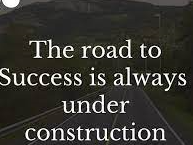
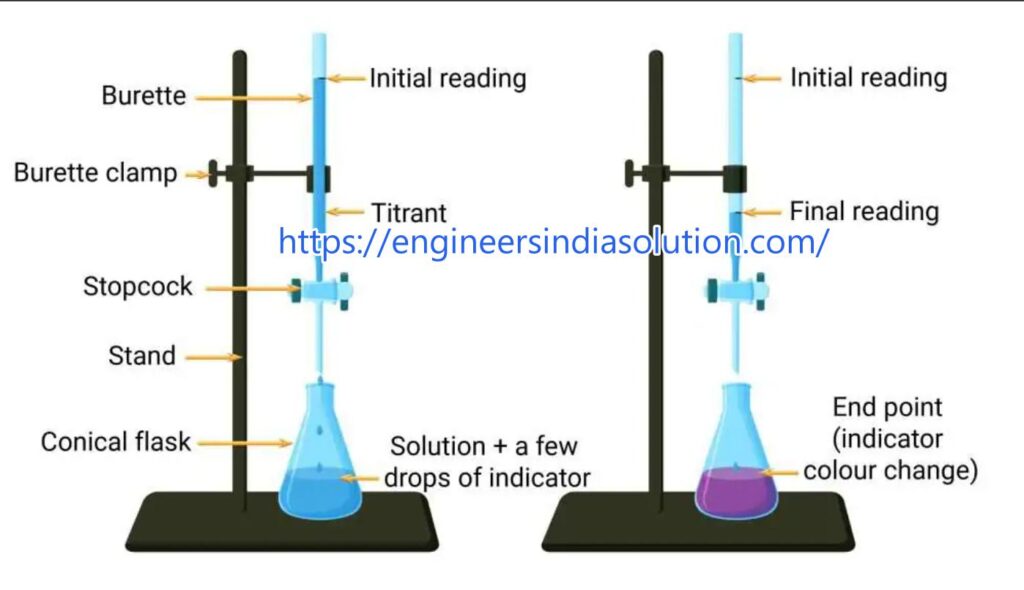
Total Hardness of given water sample by EDTA Titrimetric Method. COPY & PASTE IN ANY BROSER OR CLICK ON THE LINK BELOW किसी भी ब्राउज़र में कॉपी और पेस्ट करें या नीचे दिए गए लिंक पर क्लिक करें
https://engineersindiasolutions.blogspot.com/2024/10/total-hardness-of-given-water-sample-by.html
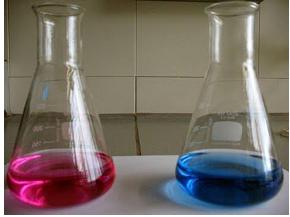
EDTA –एथिलीनडायमिनेटेट्राएसेटिक एसिड (
EDTA, एडेटेट कैल्शियम डिसोडियम
, कैल्शियम डिसोडियम वर्सेनेट) एक केलेशन एजेंट है जिसका उपयोग भारी धातु विषाक्तता के लिए किया जाता है।
Organic/inorganic solid in drinking water
permissible limit of organic solid
As per IS 456 : 2000, Ÿ Maximum permissible value of organic solids in water used in construction is 200 mg/l. Ÿ Maximum permissible value for inorganic matter in water used in construction is 3000 mg/l.
Organic impurities found in water are typically of biological origins; the decay of vegetal material gives rise to by-products such as humic and fulvic acid, tannins and lignin
Inorganic substances won’t contain a Carbon atom, whereas organic substances contain several. Thus, water is an inorganic compound because it does not contain carbon and it was not formed by a living organism. Therefore, water is an inorganic compound and a solvent.
Explanation: The desirable drinking water standard for total dissolved solids is 500 mg/l. If there are no alternate sources of water available then the permissible limit is increased to 2000 mg/l.
What are Total Suspended Solids? TSS stands for total suspended solids, and refers to waterborne particles that exceed 2 microns in size. Any particle that is smaller than 2 microns, on the other hand, is considered a total dissolved solid (TDS).
The amount of organic matter in mineral (sand, loam or clay) soils ranges from very low being 1% by weight, to average being 2 to 4%, and high being greater than 5%. There are also “muck” or organic or peat based soils that are 30 to 40% organic matter. The general consensus is the more soil organic matter the better.
Sodium chloride may impact a salty taste at 250 mg/l; however, calcium or magnesium chloride is usually detected by taste until levels of 1000 mg/l are reached. Public drinking water standards require chloride level not to exceed 250 mg
A few anions, bicarbonate, carbonate, sulfate and chloride; a few cations, calcium, magnesium, sodium and potassium; and, largely, un-dissociated silicic acid represent the largest fraction of dissolved inorganic solids in water.1
TDS is made up of inorganic salts, as well as a small amount of organic matter. Common inorganic salts that can be found in water include calcium, magnesium, potassium and sodium, which are all cations, and carbonates, nitrates, bicarbonates, chlorides and sulfates, which are all anion
Inorganic contaminants in your drinking water can pose an acute or chronic health risk or concern with conditions such as cancer, liver damage, tumors, damage to the nervous and circulatory systems, kidney disorders, bronchitis, anemia, delayed mental and physical development, gastrointestinal disorders
Dissolved organic matter (DOM) is found in every water body, both marine and freshwater. It is a heterogeneous mixture derived primarily from the decomposition products of plant material, bacteria and algae.
Every 1% increase in organic matter results in as much as 25,000 gallons of available soil water per acre. Each pound of soil organic matter (SOM) can hold up to 18 to 20 pounds of water and 1% of SOM can hold up to 1 inch of water in the soil.
Soil organic matter is the fraction of the soil that consists of plant or animal tissue in various stages of breakdown (decomposition). Most of our productive agricultural soils have between 3 and 6% organic matter. Soil organic matter contributes to soil productivity in many different ways.
The organic matter content of sands may be less than 1%; loams may have 2% to 3%, and clays from 4% to more than 5%. The strong chemical bonds that develop between organic matter and clay and fine silt protect organic molecules from attack and decomposition by microorganisms and their enzyme
The drinking water standard for chloride is a maximum level of 250 ml/L
A few anions, bicarbonate, carbonate, sulfate and chloride; a few cations, calcium, magnesium, sodium and potassium; and, largely, un-dissociated silicic acid represent the largest fraction of dissolved inorganic solids in water.
Inorganic substances won’t contain a Carbon atom, whereas organic substances contain several. Thus, water is an inorganic compound because it does not contain carbon and it was not formed by a living organism. Therefore, water is an inorganic compound and a solvent
Hydrochloric acid is a strong inorganic acid that is used in many industrial processes such as refining metal.
The term “organics” in this document means compounds that have the element carbon as a principal constituent. Organic compounds can be of many types and have many origins. Some organics in drinking water are caused by the decay of naturally occurring vegetation. These decay compounds are called lignins or tannins.
While many countries do not specifically regulate for TOC levels, the concentrations of specific volatile organic compounds are covered by legislation and recommended levels of TOC are 0.05 ml/l or less
“In surface waters, TOC concentrations are generally less than 10 mg l-1, and in groundwater less than 2 mg l-1, unless the water receives municipal or industrial wastes, or is highly coloured due to natural organic material
The technologies most suitable for organic contaminant removal in drinking water systems are granular activated carbon (GAC) and aeration. GAC has been designated by the U.S. Environmental Protection Agency (EPA) as the best available technology (BAT) for synthetic organic chemical removal
Organic matter makes up just 2–10% of most soil’s mass and has an important role in the physical, chemical and biological function of agricultural soils.
Detailed Solution
| Type of solid | Max. Permissible limit |
| Organic | 200 mg/l |
| Inorganic | 3000 mg/l |
| Sulphates | 400 mg/l |
| Chlorides | 2000 mg/l (concrete) |
पीने के पानी में कार्बनिक/अकार्बनिक ठोस
कार्बनिक ठोस की अनुमेय सीमा
आईएस 456: 2000 के अनुसार, निर्माण में उपयोग किए जाने वाले पानी में कार्बनिक ठोस का अधिकतम अनुमेय मान 200 मिलीग्राम/लीटर है। निर्माण में उपयोग किए जाने वाले पानी में अकार्बनिक पदार्थ के लिए अधिकतम अनुमेय मान 3000 मिलीग्राम/लीटर है। पानी में पाई जाने वाली कार्बनिक अशुद्धियाँ आमतौर पर जैविक मूल की होती हैं; वनस्पति पदार्थों के क्षय से ह्यूमिक और फुल्विक एसिड, टैनिन और लिग्निन जैसे उप-उत्पाद बनते हैं। अकार्बनिक पदार्थों में कार्बन परमाणु नहीं होता है, जबकि कार्बनिक पदार्थों में कई होते हैं। इस प्रकार, पानी एक अकार्बनिक यौगिक है क्योंकि इसमें कार्बन नहीं होता है और यह किसी जीवित जीव द्वारा नहीं बना है। इसलिए, पानी एक अकार्बनिक यौगिक और एक विलायक है। स्पष्टीकरण: कुल घुले हुए ठोस पदार्थों के लिए वांछनीय पेयजल मानक 500 मिलीग्राम/लीटर है। यदि पानी के कोई वैकल्पिक स्रोत उपलब्ध नहीं हैं, तो अनुमेय सीमा 2000 मिलीग्राम/लीटर तक बढ़ जाती है। कुल निलंबित ठोस पदार्थ क्या हैं? टीएसएस का मतलब है कुल निलंबित ठोस, और यह जलजनित कणों को संदर्भित करता है जो आकार में 2 माइक्रोन से बड़े होते हैं। दूसरी ओर, कोई भी कण जो 2 माइक्रोन से छोटा होता है, उसे कुल घुलित ठोस (टीडीएस) माना जाता है। खनिज (रेत, दोमट या चिकनी मिट्टी) मिट्टी में कार्बनिक पदार्थ की मात्रा बहुत कम से लेकर वजन के हिसाब से 1%, औसत 2 से 4% और उच्च 5% से अधिक होती है। “मक” या कार्बनिक या पीट आधारित मिट्टी भी हैं जो 30 से 40% कार्बनिक पदार्थ हैं। आम सहमति यह है कि मिट्टी में जितना अधिक कार्बनिक पदार्थ होगा उतना ही बेहतर होगा। सोडियम क्लोराइड 250 मिलीग्राम/लीटर पर नमकीन स्वाद को प्रभावित कर सकता है; हालांकि, कैल्शियम या मैग्नीशियम क्लोराइड को आमतौर पर स्वाद से तब तक पता लगाया जाता है जब तक कि 1000 मिलीग्राम/लीटर का स्तर नहीं पहुंच जाता और, मोटे तौर पर, असंयोजित सिलिकिक एसिड पानी में घुले अकार्बनिक ठोस पदार्थों का सबसे बड़ा हिस्सा दर्शाता है।1
TDS अकार्बनिक लवणों से बना होता है, साथ ही इसमें थोड़ी मात्रा में कार्बनिक पदार्थ भी होते हैं। पानी में पाए जाने वाले आम अकार्बनिक लवणों में कैल्शियम, मैग्नीशियम, पोटेशियम और सोडियम शामिल हैं, जो सभी धनायन हैं, और कार्बोनेट, नाइट्रेट, बाइकार्बोनेट, क्लोराइड और सल्फेट, जो सभी ऋणायन हैं
आपके पीने के पानी में अकार्बनिक संदूषक कैंसर, यकृत की क्षति, ट्यूमर, तंत्रिका और संचार प्रणालियों को नुकसान, गुर्दे के विकार, ब्रोंकाइटिस, एनीमिया, मानसिक और शारीरिक विकास में देरी, जठरांत्र संबंधी विकार जैसी स्थितियों के साथ एक तीव्र या जीर्ण स्वास्थ्य जोखिम या चिंता पैदा कर सकते हैं
घुलित कार्बनिक पदार्थ (DOM) हर जल निकाय में पाया जाता है, समुद्री और मीठे पानी दोनों में। यह मुख्य रूप से पौधों की सामग्री, बैक्टीरिया और शैवाल के अपघटन उत्पादों से प्राप्त एक विषम मिश्रण है।
मृदा कार्बनिक पदार्थ मृदा का वह अंश है जिसमें पौधे या पशु ऊतक विघटन (अपघटन) के विभिन्न चरणों में होते हैं। हमारी अधिकांश उत्पादक कृषि मृदाओं में 3 से 6% कार्बनिक पदार्थ होते हैं। मृदा कार्बनिक पदार्थ कई अलग-अलग तरीकों से मृदा उत्पादकता में योगदान देता है। रेत में कार्बनिक पदार्थ की मात्रा 1% से कम हो सकती है; दोमट मिट्टी में 2% से 3% और चिकनी मिट्टी में 4% से 5% से अधिक हो सकती है। कार्बनिक पदार्थ और मिट्टी तथा महीन गाद के बीच विकसित होने वाले मजबूत रासायनिक बंधन कार्बनिक अणुओं को सूक्ष्मजीवों और उनके एंजाइम द्वारा हमले और अपघटन से बचाते हैं। क्लोराइड के लिए पीने के पानी का मानक अधिकतम 250 मिली/लीटर है। कुछ आयन, बाइकार्बोनेट, कार्बोनेट, सल्फेट और क्लोराइड; कुछ धनायन, कैल्शियम, मैग्नीशियम, सोडियम और पोटेशियम; और, मोटे तौर पर, असंयोजित सिलिकिक एसिड पानी में घुले अकार्बनिक ठोस पदार्थों का सबसे बड़ा अंश दर्शाते हैं। अकार्बनिक पदार्थों में कार्बन परमाणु नहीं होता है, जबकि कार्बनिक पदार्थों में कई होते हैं। इस प्रकार, पानी एक अकार्बनिक यौगिक है क्योंकि इसमें कार्बन नहीं होता है और यह किसी जीवित जीव द्वारा नहीं बना है। इसलिए, पानी एक अकार्बनिक यौगिक और एक विलायक ह
कार्बनिक पदार्थ में हर 1% की वृद्धि से प्रति एकड़ 25,000 गैलन मृदा जल उपलब्ध होता है। मृदा कार्बनिक पदार्थ (एसओएम) का प्रत्येक पाउंड 18 से 20 पाउंड पानी तक धारण कर सकता है और 1% एसओएम मिट्टी में 1 इंच तक पानी धारण कर सकता है।
हाइड्रोक्लोरिक एसिड एक मजबूत अकार्बनिक एसिड है जिसका उपयोग धातु को परिष्कृत करने जैसी कई औद्योगिक प्रक्रियाओं में किया जाता है।
इस दस्तावेज़ में “ऑर्गेनिक्स” शब्द का अर्थ है ऐसे यौगिक जिनमें मुख्य घटक के रूप में कार्बन तत्व होता है। कार्बनिक यौगिक कई प्रकार के हो सकते हैं और उनकी कई उत्पत्ति हो सकती है। पीने के पानी में कुछ कार्बनिक पदार्थ प्राकृतिक रूप से पाए जाने वाले वनस्पतियों के क्षय के कारण होते हैं। इन क्षय यौगिकों को लिग्निन या टैनिन कहा जाता है। जबकि कई देश TOC स्तरों के लिए विशेष रूप से विनियमन नहीं करते हैं, विशिष्ट वाष्पशील कार्बनिक यौगिकों की सांद्रता कानून द्वारा कवर की जाती है और TOC के अनुशंसित स्तर 0.05 मिली/ली या उससे कम हैं
“सतही जल में, TOC सांद्रता आम तौर पर 10 mg l-1 से कम होती है, और भूजल में 2 mg l-1 से कम होती है, जब तक कि पानी में नगरपालिका या औद्योगिक अपशिष्ट न हों, या प्राकृतिक कार्बनिक पदार्थ के कारण अत्यधिक रंगीन न हो
पेयजल प्रणालियों में कार्बनिक संदूषक हटाने के लिए सबसे उपयुक्त तकनीकें दानेदार सक्रिय कार्बन (GAC) और वातन हैं। GAC को अमेरिकी पर्यावरण संरक्षण एजेंसी (EPA) द्वारा सिंथेटिक कार्बनिक रसायन हटाने के लिए सर्वोत्तम उपलब्ध तकनीक (BAT) के रूप में नामित किया गया है
कार्बनिक पदार्थ अधिकांश मिट्टी के द्रव्यमान का केवल 2-10% बनाते हैं और कृषि मिट्टी के भौतिक, रासायनिक और जैविक कार्य में महत्वपूर्ण भूमिका निभाते हैं।
विस्तृत समाधान
| Organic | 200 mg/l |
| Inorganic | 3000 mg/l |
| Sulphates | 400 mg/l |
| Chlorides | 2000 mg/l (concrete) |
Type of solid
Max. Permissible limit
Natural Ways to Soften Hard Water at Home – Easy DIY Solutions
Boiling is one of the simplest ways to soften hard water. …
Using Baking Soda. …
Vinegar Treatment. …
Lemon Juice. …
Using a Carbon Filter. …
Adding Epsom Salt. …
Installing a Shower Head Filter. …
Using a Magnetic Water Softene
1. Boiling
Boiling is one of the simplest ways to soften hard water. When water is boiled, the heat causes calcium and magnesium ions to precipitate out, reducing the hardness.
● How to Boil Water for Softening: Simply bring a pot of water to a boil and let it cool. The minerals will settle at the bottom, and you can pour the softened water into another container, leaving the sediment behind.
● Practical Tips: Boil water in batches and store it in clean, covered containers for daily use.
2. Using Baking Soda
Baking soda is an effective and affordable way to soften water due to its alkaline properties, which help to neutralize the minerals.
● Step-by-Step Guide: Add one teaspoon of baking soda to a gallon of water, stir well, and let it sit for a few hours before use.
● Benefits and Precautions: Baking soda not only softens water but also enhances its alkalinity. However, overuse can lead to excessive alkalinity, so it’s important to use it sparingly.
3. Vinegar Treatment
Vinegar is a natural acid that can break down minerals found in hard water, making it softer.
● Instructions: Add one cup of vinegar to a gallon of hard water, mix thoroughly, and let it sit for a few hours.
● Suggested Types and Quantities: White vinegar is commonly used, but apple cider vinegar can also be effective. Use one cup of vinegar per gallon of water for optimal results.
4. Lemon Juice
Lemon juice, with its natural acidity, is another effective method to soften water.
● Process: Squeeze the juice of one lemon into a gallon of water, mix well, and allow it to stand for a few hours.
● Additional Benefits: Lemon juice not only softens water but also adds a fresh scent and slight flavor, making it pleasant for drinking.
5. Using a Carbon Filter
Carbon filters are effective at removing chlorine and organic compounds, which can contribute to water hardness.
● Installation and Maintenance: Attach a carbon filter to your faucet or use a pitcher with a built-in filter. Replace the filter cartridges as recommended by the manufacturer.
● Benefits: Carbon filters improve water taste and odor while reducing hardness.
6. Adding Epsom Salt
Epsom salt can help in softening water by binding with the minerals.
● Guide: Dissolve one tablespoon of Epsom salt in a gallon of water and let it sit for a few hours.
● Safety Tips: While Epsom salt is generally safe, it’s important not to overuse it, as excessive magnesium can cause health issues.
7. Installing a Shower Head Filter
Shower head filters are designed to remove minerals from the water, providing a softer shower experience.
● Types and Effectiveness: Look for filters that are specifically designed to reduce hardness. Many models also remove chlorine and other impurities.
● Installation and Maintenance: These filters are easy to install and usually require cartridge replacements every few months.
8. Using a Magnetic Water Softener
Magnetic water softeners work by altering the electromagnetic properties of minerals, preventing them from sticking to surfaces.
Installation and Use: Attach the magnetic device to your water pipes as per the manufacturer’s instructions.
Pros and Cons: While easy to install and maintain, the effectiveness of magnetic softeners can vary based on water composition and flow rate.
9. Employing a Water Softening Pillow
Water-softening pillows are small, portable devices that can be placed in water to reduce hardness.
● Instructions: Place the pillow in a container of water and let it sit for the recommended time, typically a few hours.
● Advantages and Limitations: These pillows are convenient and reusable but may not be suitable for large volumes of water.
10. Using Aloe Vera
Aloe vera has natural properties that can help in softening water.
Preparation and Use: Cut an aloe vera leaf, extract the gel, and add it to a gallon of water. Mix well and let it sit for a few hours.
● Additional Benefits: Aloe vera not only softens water but also has moisturizing properties that are beneficial for the skin.
Softening hard water naturally is both eco-friendly and cost-effective. By using these ten methods, you can improve the quality of your water, protect your appliances, and enjoy healthier skin and hair. Experiment with these techniques to find the ones that work best for you, and consider combining them for enhanced effectiveness. Regularly maintaining your household appliances and monitoring water quality will ensure the best results. Try these natural water-softening methods at home and experience the difference!
घर पर कठोर पानी को नरम करने के प्राकृतिक तरीके – आसान DIY समाधान
उबालना कठोर पानी को नरम करने के सबसे सरल तरीकों में से एक है। …
बेकिंग सोडा का उपयोग करना। …
सिरका उपचार। …
नींबू का रस। …
कार्बन फ़िल्टर का उपयोग करना। …
एप्सम नमक मिलाना। …
शॉवर हेड फ़िल्टर लगाना। …
चुंबकीय जल सॉफ़्नर का उपयोग करना
1. उबालना
उबालना कठोर पानी को नरम करने के सबसे सरल तरीकों में से एक है। जब पानी को उबाला जाता है, तो गर्मी के कारण कैल्शियम और मैग्नीशियम आयन बाहर निकल जाते हैं, जिससे कठोरता कम हो जाती है। ● पानी को नरम करने के लिए कैसे उबालें: बस एक बर्तन में पानी उबालें और उसे ठंडा होने दें। खनिज नीचे बैठ जाएँगे, और आप नरम पानी को दूसरे कंटेनर में डाल सकते हैं, जिससे तलछट पीछे रह जाएगी। ● व्यावहारिक सुझाव: पानी को बैचों में उबालें और इसे दैनिक उपयोग के लिए साफ, ढके हुए कंटेनर में स्टोर करें। 2. बेकिंग सोडा का उपयोग करना
बेकिंग सोडा अपने क्षारीय गुणों के कारण पानी को नरम करने का एक प्रभावी और किफ़ायती तरीका है, जो खनिजों को बेअसर करने में मदद करता है।
● चरण-दर-चरण मार्गदर्शिका: एक गैलन पानी में एक चम्मच बेकिंग सोडा डालें, अच्छी तरह से हिलाएँ, और उपयोग करने से पहले इसे कुछ घंटों के लिए छोड़ दें।
● लाभ और सावधानियाँ: बेकिंग सोडा न केवल पानी को नरम करता है बल्कि इसकी क्षारीयता को भी बढ़ाता है। हालाँकि, अधिक उपयोग से अत्यधिक क्षारीयता हो सकती है, इसलिए इसका संयम से उपयोग करना महत्वपूर्ण है।
3. सिरका उपचार
सिरका एक प्राकृतिक एसिड है जो कठोर पानी में पाए जाने वाले खनिजों को तोड़ सकता है, जिससे यह नरम हो जाता है।
● निर्देश: एक गैलन कठोर पानी में एक कप सिरका डालें, अच्छी तरह मिलाएँ, और इसे कुछ घंटों के लिए छोड़ दें।
● सुझाए गए प्रकार और मात्रा: आमतौर पर सफ़ेद सिरका इस्तेमाल किया जाता है, लेकिन सेब साइडर सिरका भी प्रभावी हो सकता है। इष्टतम परिणामों के लिए प्रति गैलन पानी में एक कप सिरका का उपयोग करें।
4. नींबू का रस
नींबू का रस, अपनी प्राकृतिक अम्लता के कारण, पानी को नरम करने का एक और प्रभावी तरीका है।
● प्रक्रिया: एक नींबू के रस को एक गैलन पानी में निचोड़ें, अच्छी तरह मिलाएँ और इसे कुछ घंटों तक ऐसे ही रहने दें।
● अतिरिक्त लाभ: नींबू का रस न केवल पानी को नरम करता है, बल्कि इसमें एक ताज़ा खुशबू और हल्का स्वाद भी जोड़ता है, जिससे यह पीने के लिए सुखद हो जाता है।
5. कार्बन फ़िल्टर का उपयोग करना
कार्बन फ़िल्टर क्लोरीन और कार्बनिक यौगिकों को हटाने में प्रभावी होते हैं, जो पानी की कठोरता में योगदान कर सकते हैं।
● स्थापना और रखरखाव: अपने नल पर एक कार्बन फ़िल्टर लगाएँ या बिल्ट-इन फ़िल्टर वाले घड़े का उपयोग करें। निर्माता द्वारा सुझाए अनुसार फ़िल्टर कार्ट्रिज को बदलें।
● लाभ: कार्बन फ़िल्टर पानी की कठोरता को कम करते हुए स्वाद और गंध को बेहतर बनाते हैं।
6. एप्सम सॉल्ट मिलाना
एप्सम सॉल्ट खनिजों के साथ बंध कर पानी को नरम करने में मदद कर सकता है।
● गाइड: एक गैलन पानी में एक बड़ा चम्मच एप्सम सॉल्ट घोलें और इसे कुछ घंटों के लिए ऐसे ही रहने दें।
● सुरक्षा सुझाव: जबकि एप्सम नमक आम तौर पर सुरक्षित है, लेकिन इसका अधिक उपयोग नहीं करना महत्वपूर्ण है, क्योंकि अत्यधिक मैग्नीशियम स्वास्थ्य समस्याओं का कारण बन सकता है।
7. शॉवर हेड फ़िल्टर लगाना
शॉवर हेड फ़िल्टर पानी से खनिजों को हटाने के लिए डिज़ाइन किए गए हैं, जो एक नरम शॉवर अनुभव प्रदान करते हैं।
● प्रकार और प्रभावशीलता: ऐसे फ़िल्टर की तलाश करें जो विशेष रूप से कठोरता को कम करने के लिए डिज़ाइन किए गए हों। कई मॉडल क्लोरीन और अन्य अशुद्धियों को भी हटाते हैं।
● स्थापना और रखरखाव: ये फ़िल्टर स्थापित करना आसान है और आमतौर पर हर कुछ महीनों में कारतूस बदलने की आवश्यकता होती है।
8. मैग्नेटिक वॉटर सॉफ़्नर का उपयोग करना
चुंबकीय वॉटर सॉफ़्नर खनिजों के विद्युत चुम्बकीय गुणों को बदलकर काम करते हैं, उन्हें सतहों पर चिपकने से रोकते हैं।
स्थापना और उपयोग: निर्माता के निर्देशों के अनुसार अपने पानी के पाइप में चुंबकीय उपकरण संलग्न करें।
फायदे और नुकसान: स्थापित करना और रखरखाव करना आसान होने के बावजूद, चुंबकीय सॉफ़्नर की प्रभावशीलता पानी की संरचना और प्रवाह दर के आधार पर भिन्न हो सकती है।
9. वॉटर सॉफ़्निंग पिलो का उपयोग करना
वॉटर-सॉफ़्निंग पिलो छोटे, पोर्टेबल डिवाइस हैं जिन्हें कठोरता को कम करने के लिए पानी में रखा जा सकता है।
● निर्देश: तकिए को पानी के कंटेनर में रखें और इसे अनुशंसित समय, आमतौर पर कुछ घंटों के लिए ऐसे ही रहने दें।
● लाभ और सीमाएँ: ये तकिए सुविधाजनक और दोबारा इस्तेमाल करने योग्य हैं, लेकिन बड़ी मात्रा में पानी के लिए उपयुक्त नहीं हो सकते हैं।
10. एलोवेरा का उपयोग करना
एलोवेरा में प्राकृतिक गुण होते हैं जो पानी को नरम करने में मदद कर सकते हैं।
तैयारी और उपयोग: एलोवेरा की पत्ती काटें, जेल निकालें और इसे एक गैलन पानी में डालें। अच्छी तरह मिलाएँ और इसे कुछ घंटों के लिए ऐसे ही रहने दें।
● अतिरिक्त लाभ: एलोवेरा न केवल पानी को नरम करता है, बल्कि इसमें मॉइस्चराइज़िंग गुण भी होते हैं जो त्वचा के लिए फायदेमंद होते हैं।
कठोर पानी को प्राकृतिक रूप से नरम करना पर्यावरण के अनुकूल और किफ़ायती दोनों है। इन दस तरीकों का उपयोग करके, आप अपने पानी की गुणवत्ता में सुधार कर सकते हैं, अपने उपकरणों की सुरक्षा कर सकते हैं और स्वस्थ त्वचा और बालों का आनंद ले सकते हैं। इन तकनीकों के साथ प्रयोग करके अपने लिए सबसे अच्छा काम करने वाले तरीकों को खोजें और बेहतर प्रभावशीलता के लिए उन्हें संयोजित करने पर विचार करें। अपने घरेलू उपकरणों का नियमित रूप से रखरखाव करना और पानी की गुणवत्ता की निगरानी करना सर्वोत्तम परिणाम सुनिश्चित करेगा। घर पर इन प्राकृतिक जल-मृदुकरण विधियों को आज़माएं और अंतर अनुभव करें!
Determination of pH of drinking water
Apparatus and equipment: pH meter, reference electrode, sensor (glass) electrode, beakers, stirrer. Reagents and standards: pH 4 buffer solution, pH 7 buffer solution, pH 9.2 buffer solution.
Principle
The pH is determined by measurement of the electromotive force (emf) of a cell comprising of an indicator electrode (an electrode responsive to hydrogen ions such as glass electrode) immersed in the test solution and a reference electrode (usually a calomel electrode). Contact is achieved by means of a liquid junction, which forms a part of the reference electrode. The emf of this cell is measured with pH meter. Since the pH is defined operationally on a potentiometric scale, the measuring instrument is also calibrated potentiometrically with an indicating (glass) electrode and a reference electrode using standard buffers having assigned pH value so that
PHB-log₁₀ [H⁺]
Where pH = assigned pH of standard buffer. The operational pH scale is used to measure sample pH and
pHs=pHB+ F (Es-EB)/2.303 RT
nowhere, pHs = potentiometrically measured sample pH
F= Faraday 9.649 x 104 coulomb/mole
=Es= Sample emf, V
EB = Buffer emf, V
R = Gas constant = 1.987 cal deg¹ mole¹
T= absolute temperature, “K is defined as:
Procedure
(a) Before use, remove electrodes from storage solutions (recommended by the
Manufacturer) and rinse with distilled water.
(b) Dry electrodes by gently blotting with a soft tissue paper, standardize instrument With electrodes immersed in a buffer solution within 2 pH units of sample pH.
(c) Remove electrodes from the buffer, rinse thoroughly with distilled water and blot dry.
(d) Immerse in a second buffer below pH 10, approximately 3 pH units different from the first, the reading should be within 0.1 unit for the pH of the second buffer. (If the meter response shows a difference greater than 0.1 pH unit from the expected value, look for trouble with the electrodes or pH meter) and sample by
(e) For sample analysis, establish equilibrium between electrodes stirring sample to ensure homogeneity and measure pH.
(f) For buffered samples (or those with high ionic strength), condition the electrodes. after cleaning by dipping them into the same sample, and read pH.
g) With poorly buffered solutions (dilute), equilibrate electrodes by immersing in three or four successive portions of samples. Take a fresh sample and record the pH.
The pH value is obtained directly from the instrument
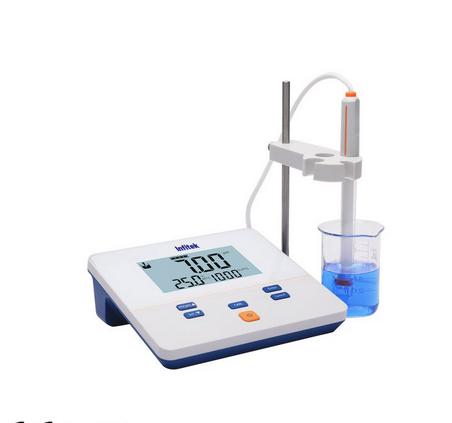
Scope of Error
1. The precision and accuracy attainable with a given pH meter will depend on the type and condition of the instrument and the care used in standardization an operation.
2. Guard against possible erratic results arising from mechanical or electrical failures-weak batteries, dam aged electrodes, plugged liquid junctions, and fouling of electrodes.
————XXXXXXXXXXXXX——————
पीने के पानी के पी०एच० {pH} का निर्धारण
उपकरण: पी०एच० मीटर, संदर्भ इलेक्ट्रोड, सेंसर (ग्लास) इलेक्ट्रोड, बीकर, स्टिरर। अभिकर्मक {REAGENTS} और {Standards } मानक: पी०एच० 4 बफर समाधान, पी०एच० 7 बफर समाधान, पी०एच० 9.2 बफर समाधान।
सिद्धांत: पीएच का निर्धारण एक सेल के इलेक्ट्रोमोटिव बल (ईएमएफ) के माप से किया जाता है जिसमें परीक्षण समाधान में डूबे एक संकेतक इलेक्ट्रोड (हाइड्रोजन आयनों जैसे ग्लास इलेक्ट्रोड के लिए उत्तरदायी इलेक्ट्रोड) और एक संदर्भ इलेक्ट्रोड (आमतौर पर एक कैलोमेल इलेक्ट्रोड) शामिल होता है। संपर्क एक तरल जंक्शन के माध्यम से प्राप्त किया जाता है, जो संदर्भ इलेक्ट्रोड का एक हिस्सा बनता है। इस सेल का ईएमएफ पीएच मीटर से मापा जाता है। चूंकि पीएच को पोटेंशियोमेट्रिक पैमाने पर क्रियात्मक रूप से परिभाषित किया जाता है, इसलिए मापने वाले उपकरण को निर्दिष्ट पीएच मान वाले मानक बफ़र्स का उपयोग करके एक संकेत (ग्लास) इलेक्ट्रोड और एक संदर्भ इलेक्ट्रोड के साथ पोटेंशियोमेट्रिक रूप से कैलिब्रेट किया जाता है ताकि
पीएचबी-लॉग10 [एच+]
जहां पीएच = मानक बफर का निर्दिष्ट पीएच। परिचालन पीएच स्केल का उपयोग नमूना पीएच को मापने के लिए किया जाता है
pHs=pHB+ F (Es-EB)/2.303 RT
कहीं नहीं, पीएच = पोटेंशियोमेट्रिक रूप से मापा गया नमूना पीएच
एफ= फैराडे 9.649 x 104 कूलम्ब/मोल
=Es=नमूना ईएमएफ, वी
ईबी = बफर ईएमएफ, वी
आर = गैस स्थिरांक = 1.987 कैल डे¹ मोल¹
टी = पूर्ण तापमान, "के को इस प्रकार परिभाषित किया गया है:
प्रक्रिया:- ए) उपयोग से पहले, भंडारण समाधान से इलेक्ट्रोड हटा दें (अनुशंसित)।
निर्माता) और आसुत जल से कुल्ला करें।
(बी) नरम टिशू पेपर से धीरे से सोखकर इलेक्ट्रोड को सुखाएं, नमूना पीएच के 2 पीएच इकाइयों के भीतर बफर समाधान में इलेक्ट्रोड को डुबोकर उपकरण को मानकीकृत करें।
(सी) बफर से इलेक्ट्रोड निकालें, आसुत जल से अच्छी तरह धोएं और सुखाएं।
(डी) पीएच 10 से नीचे दूसरे बफर में डुबोएं, पहले से लगभग 3 पीएच इकाइयां अलग, दूसरे बफर के पीएच के लिए रीडिंग 0.1 यूनिट के भीतर होनी चाहिए। (यदि मीटर प्रतिक्रिया अपेक्षित मान से 0.1 पीएच इकाई से अधिक अंतर दिखाती है, तो इलेक्ट्रोड या पीएच मीटर में समस्या देखें) और नमूना लें
(ई) नमूना विश्लेषण के लिए, एकरूपता सुनिश्चित करने और पीएच मापने के लिए नमूने को हिलाने वाले इलेक्ट्रोड के बीच संतुलन स्थापित करें।
(एफ) बफ़र किए गए नमूनों (या उच्च आयनिक शक्ति वाले) के लिए, इलेक्ट्रोड को कंडीशन करें। इन्हें एक ही नमूने में डुबोकर साफ करने के बाद पीएच पढ़ें।
छ) खराब बफर समाधान (पतला) के साथ, नमूनों के तीन या चार क्रमिक भागों में डुबो कर इलेक्ट्रोड को संतुलित करें। एक ताजा नमूना लें और पीएच रिकॉर्ड करें।
त्रुटि का दायरा

पीने के पानी के पी०एच० {pH} का निर्धारण
उपकरण: पी०एच० मीटर, संदर्भ इलेक्ट्रोड, सेंसर (ग्लास) इलेक्ट्रोड, बीकर, स्टिरर। अभिकर्मक {REAGENTS} और {Standards } मानक: पी०एच० 4 बफर समाधान, पी०एच० 7 बफर समाधान, पी०एच० 9.2 बफर समाधान।
सिद्धांत: पीएच का निर्धारण एक सेल के इलेक्ट्रोमोटिव बल (ईएमएफ) के माप से किया जाता है जिसमें परीक्षण समाधान में डूबे एक संकेतक इलेक्ट्रोड (हाइड्रोजन आयनों जैसे ग्लास इलेक्ट्रोड के लिए उत्तरदायी इलेक्ट्रोड) और एक संदर्भ इलेक्ट्रोड (आमतौर पर एक कैलोमेल इलेक्ट्रोड) शामिल होता है। संपर्क एक तरल जंक्शन के माध्यम से प्राप्त किया जाता है, जो संदर्भ इलेक्ट्रोड का एक हिस्सा बनता है। इस सेल का ईएमएफ पीएच मीटर से मापा जाता है। चूंकि पीएच को पोटेंशियोमेट्रिक पैमाने पर क्रियात्मक रूप से परिभाषित किया जाता है, इसलिए मापने वाले उपकरण को निर्दिष्ट पीएच मान वाले मानक बफ़र्स का उपयोग करके एक संकेत (ग्लास) इलेक्ट्रोड और एक संदर्भ इलेक्ट्रोड के साथ पोटेंशियोमेट्रिक रूप से कैलिब्रेट किया जाता है ताकि
पीएचबी-लॉग10 [एच+]
जहां पीएच = मानक बफर का निर्दिष्ट पीएच। परिचालन पीएच स्केल का उपयोग नमूना पीएच को मापने के लिए किया जाता है
pHs=pHB+ F (Es-EB)/2.303 RT
कहीं नहीं, पीएच = पोटेंशियोमेट्रिक रूप से मापा गया नमूना पीएच
एफ= फैराडे 9.649 x 104 कूलम्ब/मोल
=Es=नमूना ईएमएफ, वी
ईबी = बफर ईएमएफ, वी
आर = गैस स्थिरांक = 1.987 कैल डे¹ मोल¹
टी = पूर्ण तापमान, "के को इस प्रकार परिभाषित किया गया है:
प्रक्रिया:- ए) उपयोग से पहले, भंडारण समाधान से इलेक्ट्रोड हटा दें (अनुशंसित)।
निर्माता) और आसुत जल से कुल्ला करें।
(बी) नरम टिशू पेपर से धीरे से सोखकर इलेक्ट्रोड को सुखाएं, नमूना पीएच के 2 पीएच इकाइयों के भीतर बफर समाधान में इलेक्ट्रोड को डुबोकर उपकरण को मानकीकृत करें।
(सी) बफर से इलेक्ट्रोड निकालें, आसुत जल से अच्छी तरह धोएं और सुखाएं।
(डी) पीएच 10 से नीचे दूसरे बफर में डुबोएं, पहले से लगभग 3 पीएच इकाइयां अलग, दूसरे बफर के पीएच के लिए रीडिंग 0.1 यूनिट के भीतर होनी चाहिए। (यदि मीटर प्रतिक्रिया अपेक्षित मान से 0.1 पीएच इकाई से अधिक अंतर दिखाती है, तो इलेक्ट्रोड या पीएच मीटर में समस्या देखें) और नमूना लें
(ई) नमूना विश्लेषण के लिए, एकरूपता सुनिश्चित करने और पीएच मापने के लिए नमूने को हिलाने वाले इलेक्ट्रोड के बीच संतुलन स्थापित करें।
(एफ) बफ़र किए गए नमूनों (या उच्च आयनिक शक्ति वाले) के लिए, इलेक्ट्रोड को कंडीशन करें। इन्हें एक ही नमूने में डुबोकर साफ करने के बाद पीएच पढ़ें।
छ) खराब बफर समाधान (पतला) के साथ, नमूनों के तीन या चार क्रमिक भागों में डुबो कर इलेक्ट्रोड को संतुलित करें। एक ताजा नमूना लें और पीएच रिकॉर्ड करें।
त्रुटि का दायरा
1. किसी दिए गए पीएच मीटर के साथ प्राप्त होने वाली परिशुद्धता और सटीकता उपकरण के प्रकार और स्थिति और किसी ऑपरेशन के मानकीकरण मेHardness of Water
your water’s hardness based on these concentrations of calcium carbonate: Below 75 mg/L – is generally considered soft. 76 to 150 mg/L – moderately hard. 151 to 300 mg/L
Water hardness or softness is measured using grains per gallon (gpg), where one grain is equal to 0.002 ounces of calcium carbonate dissolved in 1 gallon of water. 0–3 gpg is considered soft water. 3.5–7 gpg is considered moderate and ideal
Hardness is a measure of the magnesium, calcium, and carbonate minerals in water. Water is considered soft if total hardness is less than 75 ppm, moderately hard at 75 to 150 ppm, hard at 150 to 300 ppm, and very hard at 300 ppm or higher
In drinking-water, hardness is in the range 10–500 mg of calcium carbonate per litre
he hardness of water is mainly contributed by calcium and magnesium ions. The hardness of water is defined as total parts per million (ppm) of CaCO3 by weight. For example, the hardness of water 10 ppm means 10 g of CaCO3 in one million grams of water or 0.01 g of CaCO3 in 1-L water.
Total dissolved solids of Ca++ and Mg++ in soft water should be up to 200 ppm. Soft water is used for drinking water. Water used for drinking is unpalatable if the TDS level of it is above 500 ppm. As per standards, the acceptable limit of TDS is 200ppm
emporary hardness can be removed by boiling, but permanent hardness cannot be removed with this method. Water softening at home can be done using a resin coated with sodium. Other methods of removing hardness include Clark’s process, Calgon’s process, and ion-exchange resin.
The amount of hardness is expressed in milligrams per litre (mg/L) or grains per gallon (gpg) as calcium carbonate. Hardness is calculated from the equation Hardness = 2.497 (Ca) + 4.118 (Mg). Therefore, fluctuations in the magnesium pool affect hardness stronger than do calcium fluctuations
Understanding Water Hardness Levels In Your Home Water. The Short Answer Is: A good water hardness level for your home typically falls between 3.5 and 7 grains per gallon. Water within this range is considered moderately hard and is generally safe for household use.
________XXXXXXXXXXXXXXXXXXXXXXXXXXXXXXXXXXXXXXX__________________________
पानी की कठोरता
कैल्शियम कार्बोनेट की इन सांद्रताओं के आधार पर आपके पानी की कठोरता: 75 mg/L से कम – आम तौर पर नरम माना जाता है। 76 से 150 mg/L – मध्यम रूप से कठोर। 151 से 300 mg/L
पानी की कठोरता या कोमलता को प्रति गैलन अनाज (gpg) का उपयोग करके मापा जाता है, जहाँ एक अनाज 1 गैलन पानी में घुले 0.002 औंस कैल्शियम कार्बोनेट के बराबर होता है। 0–3 gpg को नरम पानी माना जाता है। 3.5–7 gpg को मध्यम और आदर्श माना जाता है
कठोरता पानी में मैग्नीशियम, कैल्शियम और कार्बोनेट खनिजों का एक माप है। यदि कुल कठोरता 75 पीपीएम से कम है तो पानी को नरम माना जाता है, 75 से 150 पीपीएम पर मध्यम कठोर, 150 से 300 पीपीएम पर कठोर और 300 पीपीएम या उससे अधिक पर बहुत कठोर माना जाता है। पीने के पानी में कठोरता 10-500 मिलीग्राम कैल्शियम कार्बोनेट प्रति लीटर की सीमा में होती है। पानी की कठोरता में मुख्य रूप से कैल्शियम और मैग्नीशियम आयनों का योगदान होता है। पानी की कठोरता को वजन के हिसाब से CaCO3 के कुल भाग प्रति मिलियन (पीपीएम) के रूप में परिभाषित किया जाता है। उदाहरण के लिए, 10 पीपीएम पानी की कठोरता का मतलब है एक मिलियन ग्राम पानी में 10 ग्राम CaCO3 या 1 लीटर पानी में 0.01 ग्राम CaCO3। नरम पानी में Ca++ और Mg++ के कुल घुले हुए ठोस 200 पीपीएम तक होने चाहिए। पीने के पानी के लिए नरम पानी का इस्तेमाल किया जाता है। पीने के लिए इस्तेमाल किया जाने वाला पानी अगर इसका टीडीएस स्तर 500 पीपीएम से ऊपर है तो पीने योग्य नहीं है। मानकों के अनुसार, TDS की स्वीकार्य सीमा 200ppm है
अस्थायी कठोरता को उबालकर हटाया जा सकता है, लेकिन इस विधि से स्थायी कठोरता को नहीं हटाया जा सकता है। घर पर पानी को नरम बनाने के लिए सोडियम के साथ लेपित राल का उपयोग किया जा सकता है। कठोरता को दूर करने के अन्य तरीकों में क्लार्क की प्रक्रिया, कैलगन की प्रक्रिया और आयन-एक्सचेंज राल शामिल हैं।
कठोरता की मात्रा को कैल्शियम कार्बोनेट के रूप में मिलीग्राम प्रति लीटर (mg/L) या ग्रेन प्रति गैलन (gpg) में व्यक्त किया जाता है। कठोरता की गणना समीकरण कठोरता = 2.497 (Ca) + 4.118 (Mg) से की जाती है। इसलिए, मैग्नीशियम पूल में उतार-चढ़ाव कैल्शियम के उतार-चढ़ाव की तुलना में कठोरता को अधिक प्रभावित करते हैं
अपने घर के पानी में पानी की कठोरता के स्तर को समझना। संक्षिप्त उत्तर है: आपके घर के लिए एक अच्छा पानी की कठोरता का स्तर आमतौर पर 3.5 और 7 ग्रेन प्रति गैलन के बीच होता है। इस सीमा के भीतर पानी को मध्यम रूप से कठोर माना जाता है और आम तौर पर घरेलू उपयोग के लिए सुरक्षित होता है।
JAR TEST
- Introduction:
Colloidal impurities present in water cannot be separated from water by ordinary sedimentation. These impurities have negative electrical charge due to which their particles are always mobile and do not come to the bottom of the sedimentation tank. Apart from this, very fine particles of clay, silt etc. remain in suspended state in water whose rate of sedimentation (settling down) is very low.
It is not practical to remove these impurities by ordinary sedimentation because in this case the detention period of the sedimentation tank will have to be kept longer due to which a lot of space will be required. Therefore, there is a need to increase the sedimentation rate of fine particles by some method.
For this, some special chemicals are added to the water before sedimentation which are called coagulants. On adding coagulant to water, sticky, thick, membraneous particles (flocs) are formed which spread throughout the tank and slowly settle down and taking all the impurities and bacteria in their lap, settle at the bottom in the form of sludge. Completing the sedimentation process by adding coagulant is called sedimentation with coagulation. This completes the sedimentation process quickly and also removes colour and odour from the water. When the turbidity of water is more than 40 p.p.m, sedimentation with coagulation should be done.
The following chemicals are mainly used as coagulants— (i) Aluminium sulphate (alum)
(ii) Ferrous sulphate (iii) Ferric sulphate
(iv) Ferric chloride
(v) Calcium hydroxide etc.
Alum is cheaper and more effective than other chemicals and is more popular due to its easy availability. However, nowadays many types of polymers are also used in modern plants which are very effective. Despite this, alum is a very popular coagulant.
The best coagulation process takes place on a certain amount of alum. Therefore, for best and economical coagulation process, the optimum dose of alum should be found. The optimum amount of alum is found by testing. The description of which is given below.
- Objective: To find the optimum amount of coagulant for the water sample given by jar test in the laboratory. 3. Apparatus:
Jar test apparatus, voltage stabilizer
- Glass items:
6 jars of 1 liter capacity, pipettes.
- Reagents :
Alum solution of 1% concentration
- Theory :
Alum is used as a coagulant in large quantities every day at water works, so it is very important that the amount of alum added is fully effective and not more than required so that it remains economical. The proper amount of alum is determined on the basis of the bubbles formed by it. Therefore, the minimum amount of coagulant, which when mixed in raw water forms the maximum bubbles, is called the optimum dose of the coagulant.
The optimum amount of coagulant is determined by jar test. The jar test apparatus has a platform at the bottom inside which a fluorescent tube is fitted. The upper surface of this platform is made of glass so that the object placed on the platform is clearly visible in the light of the tube light. 6 transparent jars of one liter capacity are kept at equal distance on the platform. These jars are filled with sample and coagulant solution which has a mechanical arrangement for stirring. For this purpose, separate vertical shaking rods are fitted in each jar, on the lower end of which a pedal is fitted. The upper end of all the vertical rods is connected to a horizontal rod in such a way that on rotating the horizontal rod, all the vertical rods rotate at the same speed. This horizontal rod is called driving shaft, for rotating which mechanical arrangement is made.
- Procedure: 1. First of all, 6 jars of one liter capacity are taken and equal quantity of water sample is filled in them.
Experimental part
- Now, with the help of a pipette, add 1% alum solution in each jar in different quantities (e.g. 1.0 ml in the first jar, 2.0 ml in the second jar, 3.0 ml in the third jar).
Driving Shaft
Glass Jar
Driving. Unit
Stirring Rod
Glass Sheet
Pedal
Platform
Tube Light
Jar Test Apparatus
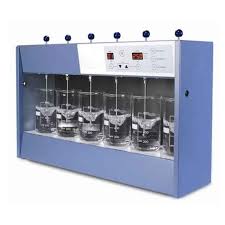
Figure 3- Jar Test Apparatus
- The vertical shaking rods are lowered. 4. All the rods are rotated rapidly (120 revolutions per minute) for 3 to 5 minutes so that the coagulant dissolves well.
- After this, the pedals are rotated slowly (20 revolutions per minute) for 15 to 20 minutes. This is done because the particles break up when rotated rapidly and after breaking the particles do not get rejoined.
- After this they are allowed to remain calm for 2 hours so that the particles
settle on the bottom.
- Carefully study the particles formed in each jar in the light of the tube light placed below.
- The quantity of coagulant added in the jar in which the maximum number of particles are formed is called the optimum quantity. Clearly, if almost equal number of particles are formed in two jars, then the quantity of coagulant added in less quantity will be the optimum quantity.
- If it seems difficult to conclude by looking at it, then take out 1_10 ml sample from each jar and test it.
जार परीक्षण (JAR TEST)
1. परिचय (Introduction) :
पानी में उपस्थित कोलाइडी अशुद्धियाँ साधारण अवसादन द्वारा पानी से अलग नहीं की जा सकती हैं। इन अशुद्धियों में ऋणात्मक विद्युत आवेश रहता है जिस कारण इनके कण सदैव गतिशील रहते हैं और अवसादन टैंक की तली पर नहीं आ पाते हैं । इसके अतिरिक्त पानी में मृतिका, सिल्ट आदि के बहुत महीन ar निलम्बित अवस्था में रहते हैं जिनकी अवसादन ( नीचे बैठने) की दर बहुत ही कम होती है
इन अशुद्धियों को साधारण अवसादन (plain sedimentation) द्वारा हटाना व्यवहारिक नहीं है क्योंकि इस स्थिति में अवसादन टैंक का रोक काल (detention period) अधिक रखना पड़ेगा जिससे बहुत अधिक स्थान की आवश्यकता होगी । अतः महीन कणों की अवसादन दर को किसी विधि द्वारा बढ़ाने की आवश्यकता होती है ।
इसके लिये पानी में अवसादन से पूर्व कुछ विशेष रसायन मिला दिये जाते हैं जिन्हें स्कन्दक (coagulant) कहते हैं। पानी में स्कन्दक मिलाने पर चिपचिपी, गाढ़ी, झिल्लीदार कणिका ( flocs ) बनती हैं जो पूरे टैंक में फैलकर धीरे-धीरे नीचे की ओर बैठती हैं तथा अपने आगोश में सभी अशुद्धियों तथा जीवाणुओं को लेती हुई आपंक (sludge) के रूप में नीचे तली पर बैठ जाती हैं । स्कन्दक मिलाकर अवसादन क्रिया पूर्ण करने को स्कन्दन सहित अवसादन कहते हैं । इससे अवसादन क्रिया जल्दी पूरी हो जाती है तथा पानी से रंग व गन्ध भी दूर हो जाते हैं। पानी का गदलापन 40p. p. m से अधिक होने पर स्कन्दन सहित अव- सादन किया जाना चाहिये ।
स्कन्दक के रूप में मुख्यतः निम्न रसायनों का प्रयोग किया जाता है— (i) एल्यूमिनियम सल्फेट ( फिटकरी )
(ii) फेरस सल्फेट (iii) फैरिक सल्फेट
(iv) फैरिक क्लोराइड
(v) कैल्शियम हाइड्राक्साइड आदि ।
फिटकरी अन्य रसायनों की अपेक्षा सस्ती तथा प्रभावी होती है तथा सहज उपलब्धता के कारण अधिक प्रचलित है। वैसे आजकल आधुनिक संयन्त्रों में कई प्रकार के
पॉलिमर (polymers) भी प्रयोग किये जाते हैं जो बहुत अधिक प्रभावी हैं। इसके उपरांत भी फिटकरी एक बहु प्रचलित स्कंदक है ।
उत्तम स्कंदन क्रिया फिटकरी की एक निश्चित मात्रा पर होती है | अतः उत्तम व मितव्ययी स्कंदन क्रिया के लिये फिटकरी की अनुकूलतम मात्रा (optimum dose) ज्ञात की जानी चाहिये। फिटकरी की अनुकूलतम मात्रा जा परीक्षण द्वारा ज्ञात की जाती । जिसका वर्णन नीचे दिया गया है ।
2. उद्देश्य (Object) : प्रयोगशाला में जार परीक्षण (JAR TEST) द्वारा दिए गए जल प्रतिद
के लिये स्कन्दक की अनुकूलतम मात्रा ज्ञात करना । 3. उपकरण (Apparatus) :
जार परीक्षण उपकरण, वोल्टेज स्टेबलाइजर (voltage stabilizer)
4. कांच के सामान :
1 लीटर धारिता के 6 जार, पिपेट |
5. रसायन (Reagents) :
1% सांद्रता का फिटकरी का घोल
6. सिद्धांत (Theory ) :
वाटर वर्क्स पर प्रतिदिन अत्याधिक मात्रा में स्कन्दक के रूप में फिटकरी का प्रयोग किया जाता है अतः यह अत्यन्त आवश्यक है कि मिलायी गयी फिटकरी की मात्रा पूर्णतः प्रभावी हो व आवश्यकता से अधिक न हो ताकि वह मितव्ययी रहे। फिटकरी की उचित मात्रा का निर्धारण उसके द्वारा बनायी गयी उणिका के आधार पर किया जाता है । अतः स्कन्दक की वह न्यूनतम मात्रा, जिसे कच्चे पानी में मिलाने पर अधिकतम ऊणिका बने, स्कन्दक की अनुकूलतम मात्रा (optimum dose) कहलाती है
स्कन्दक की अनुकूलतम मात्रा जार परीक्षण ( Jar Test) द्वारा ज्ञात की जाती है । जार परीक्षण उपकरण में नीचे एक प्लेटफार्म होता है जिसके अन्दर एक प्रकाशीय ट्यूब ( Fluorescent Tube light) फिट होती है । इस प्लेटफार्म का ऊपरी तल कांच का होता है ताकि ट्यूबलाइट के प्रकाश में प्लेटफार्म पर रखी वस्तु स्पष्ट दिखायी दे । प्लेटफार्म पर एक लीटर धारिता के पारदर्शी 6 जार समान दूरी पर रखे होते हैं। इन जारों में प्रतिदर्श व स्कन्दक का घोल भरा जाता है जिसे हिलाने की यांत्रिक व्यवस्था होती है। इस कार्य हेतु प्रत्येक जार में अलग-2 उदग्र विड़ोलन छड़ लगायी जाती हैं जिनके निचले सिरे पर एक पेडल लगाया जाता है। सभी उदग्र छड़ों का ऊपरी सिरा, एक क्षैतिज छड़ से इस प्रकार जुड़ा रहता है कि क्षैतिज छड़ को घुमाने पर सभी उदग्र छड़ें समान गति से घूमती हैं। इस क्षैतिज छड़ को परिचालक शाफ्ट (driving shafi ) कहते हैं जिसे घुमाने हेतु यांत्रिक व्यवस्था की जाती है ।
7. कार्य विधि (Procedure) : 1. सर्वप्रथम एक लीटर क्षमता वाले 6 जार लेकर उनमें बराबर – 2 मात्रा में जल प्रतिदर्श भर दिया जाता है।
प्रयोगात्मक भाग
2. अब प्रत्येक जार में 1% फिटकरी घोल को पिपेट की सहायता से अलग- अलग मावा (जैसे पहले जार में 1.0ml दूसरे जार में 2.0ml, तीसरे जार में 3.0ml”””’) डालते हैं ।
Driving Shaft
Glass Jar
Driving. Unit
Stirring Rod
Glass Sheet
Pedal
Platform
Tube Light
Jar Test Apparatus
चित्र 3- जार परीक्षण उपकरण

3. उदग्र विड़ोलन छड़ों को नीचे कर लेते हैं । 4. 3 से 5 मिनट तक सभी छड़ों को तेजी से ( 120 चक्र प्रति मिनट ) घुमाया जाता है ताकि स्कन्दक अच्छी प्रकार घुल जाए ।
5. इसके पश्चात् 15 से 20 मिनट तक पैंडलों को धीरे-धीरे (20 चक्र प्रति मिनट) घुमाया जाता है । ऐसा इसलिए किया जाता है क्योंकि तेजी से घुमाते रहने पर कणिका टूट जाती हैं तथा ऊणिका टूटने के बाद पुनः संयोजित नहीं हो पाती हैं।
6. इसके बाद इन्हें 2 घन्टे तक शान्त रहने दिया जाता है, ताकि ऊणिका
तली पर बैठ जाए।
7. नीचे लगी ट्यूबलाइट के प्रकाश में सावधानी पूर्वक प्रत्येक जार में बनी ऊणिका का अध्ययन करते हैं ।
8. जिस जार में सबसे अधिक ऊणिका बने, उस जार में मिलायी गयी स्कन्दक की मात्रा ही अनुकूलतम मात्रा कहलाती है। स्पष्टतः यदि दो जारों में लगभग समान उणिका बनती है तो कम मात्रा में मिलायी गयी स्कन्दक की मात्रा ही अनुकूलतम मात्रा होगी।
9. यदि देख कर निष्कर्ष निकालना कठिन प्रतीत हो तो प्रत्येक जार से 1_10 ml प्रतिदर्श निकाल कर उसकी Turbidity ज्ञात कर लें तथा जिस जार में गदलापन सबसे कम हो वही वांछित जार होगा तथा उस जार में मिलायी गयी स्कन्दक की मात्रा ही अनुकूलतम मात्रा होगी। प्रतिदर्श निकालते समय जा विक्षोभ म्यूनतम होना चाहिए तथा प्रतिदर्श ऊपर से ही ले लेना चाहिये। 8. प्रेक्षण तालिका (Observation sheet) :
Sample Details Source etc.
Jar No.
Volume [ of Sample (litre)
Dose of Coagulant 1% alum Solution (ml.)
Residual Turbidity
Optim dose coagulants
9. परिणाम (Result ) : जल प्रतिदर्श के लिए स्कन्दक की अनुकूलतम मात्रा mg / lit है
10. सावधानियाँ (Precautions ) : 1. परीक्षण करने से पूर्व उपकरण के बारे में पूर्ण जानकारी प्राप्त कर
चाहिए ।
2. स्कन्दक मिलाते समय सावधानी बरतनी चाहिये । 3. ऊर्णिका के बारे में निर्णय काफी सावधानी से लिया जाना चाहिये।
4. अनुकूलतम मात्रा ज्ञात करने में मितव्ययता का भी ध्यान र चाहिए।
How does oil and grease affect the water?

Fats, oils, and grease poured or washed into stormwater collection systems can accumulate and impair stormwater flow, and these pollutants ultimately discharge directly into a local waterway, untreated.
How do you test oil and grease in water?
OG in water is commonly determined by extraction into a non-polar, hydrocarbon- free solvent followed by measurement of the infrared absorption spectrum of the extract. The absorption between 3000 and 2900 cm-1 by C-H groups in the OG is correlated to the concentration of OG.
What happens to grease in water?
Grease is singled out for special attention because of its poor solubility in water and its tendency to separate from the liquid solution.
What causes oil and grease in wastewater?
Fats, oils, and grease (FOG) comes from meat fats in food scraps, cooking oil, shortening, lard, butter and margarine, gravy, and food products such as mayonnaise, salad dressings, and sour cream. FOG poured down kitchen drains accumulates inside sewer pipes
Does oil and grease float in water?
Oil and grease floats on the water surface and accumulates behind the grease retaining fittings and the wall separating the compartments. The oil and grease will be removed during routine grease interceptor cleaning.
What is oil and grease test?
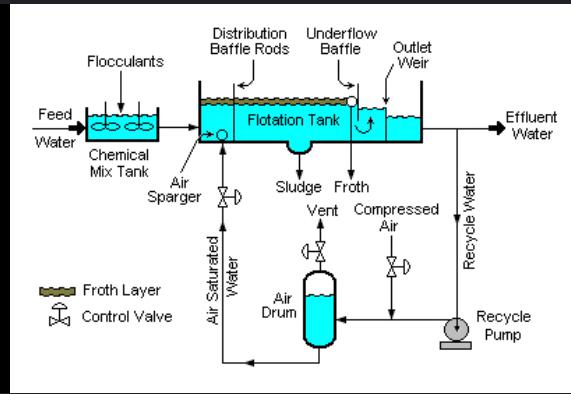

Oil & Grease testing determines the amount of non-volatile hydrocarbons (i.e. petroleum derivatives), vegetable oils, animal fats, waxes, soaps, greases and related material in a sample.
How do you reduce oil and grease in water?
Removal requires chemical addition to lower the pH followed by addition of dissolved oxygen or nitrogen to remove the emulsified oils as they break free from the wastewater. Dissolved Oil is a true molecular solution within the water and can only be removed with biological treatment.
Does grease react with water?
In general, a grease shows high resistance to water if its individual components do not react with water and are soluble in water (Blanke and Bartz (17))
Carboxymethyl cellulose, or CMC, is one popular material used to create a water-based analog of greases.
Why does grease float on water?
Grease is 10 to 15 percent less dense than water and doesn’t mix with water. This results in grease (FOG – fats, oils grease) floating on top of water.
Does oil grease dissolve in pure water?
Oils and fats not have any polar part and so for them to dissolve in water they would have to break some of water s hydrogen bonds. Water will not do this so the oil is forced to stay separate from the water
What is the limit of oil and grease in wastewater?
recommended 100 mg/L as a maximum limit for oil & grease. range of 16 mg/L to 105 mg/L.
How much oil and grease is in wastewater?
Oil and grease are present in wastewater in a 10% approximately [13], with a concentration range between 10 to 100 mg/L [14].24-Apr-2019
What causes oil to sink in water?
If you choose an oil with a low coefficient of expansion, its density may stay close to its original value as the water’s density decreases with heating. If you can get the water’s density low enough before it boils, the oil will sink.
Why does grease react to water?
Even a small amount of water dropped into a pan or deep fryer filled with burning oil will sink to the bottom, become superheated and erupt. According to the Scientific American, the reason oils do not mix with water is related to their properties. Water molecules are polar, and oils are nonpolar.
Is grease a fatty acid?
Fats, oils, and grease (FOG) compounds consist of fatty acids and glycerol.
What is TPH in water analysis?
Total petroleum hydrocarbons is a term used to describe a large group of chemical compounds. They are all sourced from crude oil. They include naphthalene, benzene, toluene and other toxic chemicals. Obtaining the total count of TPH determines the extent of water contamination.
Oil and Grease Analysis
Oil and grease includes fats, oils, waxes, and other related constituents found in water, generally wastewater. If these compounds are not removed before discharge of treated wastewater, oil and grease can interfere with biological life in surface waters and create unsightly films.
Fats and oils are contributed to domestic wastewater in butter, lard, margarine, and vegetable fats and oils. Fats are also commonly found in meats, in the germinal area of cereals, in seeds, in nuts, and in certain fruits. The low solubility of fats and oils reduces their rate of microbial degradation.
Kerosene, lubricating, and road oils are derived from petroleum and coal tar and contain essentially carbon and hydrogen. These oils can reach sewers in considerable volume from shops, garages, and streets. The mineral oils coat surfaces to a greater extent than fats, oils, and soaps, and the particles interfere with biological action and cause maintenance problems.
EPA method 1664 uses n-hexane as the extraction solvent for Oil and Grease and other extractable material that is not adsorbed by silica gel in surface and saline waters, and industrial and domestic aqueous waste. N-hexane extracts non-volatile hydrocarbons, vegetable oils, animal fats, waxes, soaps, greases, and related materials. Petroleum fuels and gasoline through Diesel #2 fuel oil are also extracted by n-hexane; however, they may be partially lost due to solvent removal operations (materials that volatilize below 85°C). Some crude and heavy fuel oils contain materials that are not soluble in n-hexane, resulting in low recoveries.
The previous accepted methods, EPA 413.1 and 418.1, used Freon (CFC-113) as the extraction solvent. N-Hexane was chosen as the alternate solvent because it most closely approximated the results of the Freon extractions. Total Petroleum Hydrocarbons (TPH, or the hydrocarbon portion of Oil and Grease) was determined using an Infrared Spectrophotometer, and with the updated method (EPA 1664) TPH can be determined gravimetrically. Unfortunately, EPA 1664 is less robust compared to the previous methods for TPH because the volatile compounds are lost when the solvent is evaporated.
The oil and grease method requires samples to be collected in glass, and the bottle must not be pre-rinsed with sample before collection. Oil and Grease compounds are hydrophobic and prefer to associate with the glass container rather than the water of the collected sample. If sample analysis is delayed, the sample must be preserved to a pH <2 with hydrochloric (HCl) or sulfuric acid (H2SO4). All samples must be kept cool after collection (≤6°C). If it is suspected or known that the sample will contain a large concentration of extractable material (>500 mg/L), a smaller volume is appropriate. All samples collected for this analysis are grab samples. If a composite is required, additional volume in separate containers is necessary and the laboratory can perform the composite (whole volume collected) upon analysis. The regulatory hold time for the analysis is 28 days from the date and time of collection.
At the time of the Oil and Grease analysis, the laboratory verifies the pH preservation and will add additional acid if the pH is not <2. The Oil and Grease in the collected sample is extracted using n-hexane. The sample is transferred to a separatory funnel, receives 30 mL of n-hexane, mixed vigorously, and allowed to settle to let the organic and aqueous phases separate. The lower layer (aqueous layer) is drained into the original sample container, and the hexane layer remains in the separatory funnel. The hexane extract is drained through a funnel containing anhydrous sodium sulfate to remove any excess water from the extract and is collected in a pre-weighed container (flask or pan) to evaporate the hexane. The original sample goes through the process two more times to remove all Oil and Grease compounds for the analysis. Once the three extract portions are collected, the solvent is evaporated and the pre-weighed container is weighed to constant weight. The difference in mass is the amount of Oil and Grease in the collected sample.
To determine the Hydrocarbon portion of the Oil and Grease analysis, the sample is re-constituted with n-hexane. Silica gel is added to the sample in the ratio of 3 grams for every 100 mg of hexane extractable material. Once mixed, the slurry is filtered, and the filtrate is heated to evaporate the hexane to leave behind the Hydrocarbon fraction in a pre-weighed vessel.
In order to improve laboratory efficiency by automating this analysis, Caltest has two extraction systems developed by Horizon Technology (SPE DEX 3000XL). The system utilizes Solid Phase Extraction (SPE) to sorb the oil and grease compounds, and elute the sorbed compounds using methanol. SPE molecular-level processes (from Horizon Technolo Elution process at a molecular level (from Horizon Technology).
This automated process reduces the volume of solvent used in the extraction process, and therefore reduces hazardous waste. The reduced volume of solvent also improves the safety for the analyst. Additionally, the likelihood of emulsions forming is eliminated, reducing the variability and speeding completion of the extraction step.
Environmental Protection Agency (EPA). 1999. Method 1664, Revision A: N-Hexane extractable material (HEM; Oil and Grease) and Silica Gel Treated n-hexane extractable material (SGT-HEM; Non-Polar Material) by Extraction and Gravimetry. EPA-821-R98-002. Office of Water, Washington, DC.
EPA. Oil and Grease: Questions and Answers. Last updated September 12, 2013. Available online at http://water.epa.gov/scitech/methods/cwa/oil/oilfaq.cfm
Hamel, M., and J. Fenster. Maintainng regulatory method compliance while automating oil and grease analysis. Horizon Technology, Salem, NH. Available online at: http://www.horizontechinc.com/PDF/white papers/Maintaining Regulatory Method Compliance while Automating Oil and Grease Analysis-Long (3).pdf
EditSign
For more information, or a quote, please call us or email info@caltestlabs.com
तेल और ग्रीस पानी को कैसे प्रभावित करते हैं?


स्टॉर्मवॉटर कलेक्शन सिस्टम में डाले गए या धोए गए वसा, तेल और ग्रीस जमा हो सकते हैं और स्टॉर्मवॉटर के प्रवाह को खराब कर सकते हैं, और ये प्रदूषक अंततः स्थानीय जलमार्ग में सीधे बिना उपचारित किए निकल जाते हैं।
आप पानी में तेल और ग्रीस का परीक्षण कैसे करते हैं?
पानी में OG का निर्धारण आमतौर पर एक गैर-ध्रुवीय, हाइड्रोकार्बन-मुक्त विलायक में निष्कर्षण द्वारा किया जाता है, उसके बाद अर्क के अवरक्त अवशोषण स्पेक्ट्रम का मापन किया जाता है। OG में C-H समूहों द्वारा 3000 और 2900 cm-1 के बीच अवशोषण OG की सांद्रता से संबंधित है।
पानी में ग्रीस का क्या होता है?
ग्रीस को पानी में इसकी खराब घुलनशीलता और तरल घोल से अलग होने की प्रवृत्ति के कारण विशेष ध्यान देने के लिए चुना जाता है।
अपशिष्ट जल में तेल और ग्रीस का क्या कारण है?
वसा, तेल और ग्रीस (FOG) खाद्य स्क्रैप, खाना पकाने के तेल, शॉर्टनिंग, लार्ड, मक्खन और मार्जरीन, ग्रेवी और मेयोनेज़, सलाद ड्रेसिंग और खट्टा क्रीम जैसे खाद्य उत्पादों में मांस वसा से आते हैं। रसोई की नालियों में डाला गया फ़ॉग सीवर पाइप के अंदर जमा हो जाता है
क्या तेल और ग्रीस पानी में तैरते हैं?
तेल और ग्रीस पानी की सतह पर तैरते हैं और ग्रीस को बनाए रखने वाली फिटिंग और डिब्बों को अलग करने वाली दीवार के पीछे जमा हो जाते हैं। नियमित ग्रीस इंटरसेप्टर की सफ़ाई के दौरान तेल और ग्रीस को हटा दिया जाएगा।
तेल और ग्रीस परीक्षण क्या है?
तेल और ग्रीस परीक्षण एक नमूने में गैर-वाष्पशील हाइड्रोकार्बन (यानी पेट्रोलियम डेरिवेटिव), वनस्पति तेल, पशु वसा, मोम, साबुन, ग्रीस और संबंधित सामग्री की मात्रा निर्धारित करता है।
आप पानी में तेल और ग्रीस को कैसे कम करते हैं?
हटाने के लिए पीएच को कम करने के लिए रासायनिक मिश्रण की आवश्यकता होती है, इसके बाद अपशिष्ट जल से मुक्त होने पर पायसीकृत तेलों को हटाने के लिए घुलित ऑक्सीजन या नाइट्रोजन को मिलाया जाता है। घुला हुआ तेल पानी के भीतर एक वास्तविक आणविक घोल है और इसे केवल जैविक उपचार से ही हटाया जा सकता है।
क्या ग्रीस पानी के साथ प्रतिक्रिया करता है? सामान्य तौर पर, एक ग्रीस पानी के प्रति उच्च प्रतिरोध दिखाता है यदि इसके अलग-अलग घटक पानी के साथ प्रतिक्रिया नहीं करते हैं और पानी में घुलनशील हैं (ब्लैंक और बार्टज़ (17)) कार्बोक्सिमिथाइल सेलुलोज, या सीएमसी, एक लोकप्रिय सामग्री है जिसका उपयोग ग्रीस के पानी-आधारित एनालॉग बनाने के लिए किया जाता है। ग्रीस पानी पर क्यों तैरता है? ग्रीस पानी की तुलना में 10 से 15 प्रतिशत कम घना होता है और पानी के साथ नहीं मिलता है। इसके परिणामस्वरूप ग्रीस (FOG – वसा, तेल ग्रीस) पानी के ऊपर तैरता है। क्या तेल ग्रीस शुद्ध पानी में घुल जाता है? तेल और वसा में कोई ध्रुवीय भाग नहीं होता है और इसलिए उन्हें पानी में घुलने के लिए पानी के कुछ हाइड्रोजन बॉन्ड को तोड़ना होगा। पानी ऐसा नहीं करेगा इसलिए तेल पानी से अलग रहने के लिए मजबूर है अपशिष्ट जल में तेल और ग्रीस की सीमा क्या है? तेल और ग्रीस के लिए अधिकतम सीमा के रूप में 100 मिलीग्राम/लीटर की सिफारिश की गई है। 16 मिलीग्राम/लीटर से 105 मिलीग्राम/लीटर की सीमा। अपशिष्ट जल में कितना तेल और ग्रीस है? तेल और ग्रीस अपशिष्ट जल में लगभग 10% [13] में मौजूद होते हैं, जिनकी सांद्रता 10 से 100 mg/L [14] के बीच होती है। 24-अप्रैल-2019
तेल पानी में क्यों डूब जाता है?
यदि आप कम विस्तार गुणांक वाला तेल चुनते हैं, तो इसका घनत्व अपने मूल मान के करीब रह सकता है क्योंकि पानी का घनत्व गर्म होने पर कम हो जाता है। यदि आप पानी के घनत्व को उबलने से पहले काफी कम कर सकते हैं, तो तेल डूब जाएगा।
ग्रीस पानी से क्यों प्रतिक्रिया करता है?
जलते हुए तेल से भरे पैन या डीप फ्रायर में पानी की थोड़ी मात्रा भी नीचे डूब जाएगी, सुपरहीट हो जाएगी और फट जाएगी। साइंटिफिक अमेरिकन के अनुसार, तेलों के पानी के साथ न मिलने का कारण उनके गुणों से संबंधित है। पानी के अणु ध्रुवीय होते हैं, और तेल अध्रुवीय होते हैं।
क्या ग्रीस एक फैटी एसिड है?
वसा, तेल और ग्रीस (FOG) यौगिकों में फैटी एसिड और ग्लिसरॉल होते हैं।
जल विश्लेषण में TPH क्या है?
कुल पेट्रोलियम हाइड्रोकार्बन एक शब्द है जिसका उपयोग रासायनिक यौगिकों के एक बड़े समूह का वर्णन करने के लिए किया जाता है। ये सभी कच्चे तेल से प्राप्त होते हैं। इनमें नेफ़थलीन, बेंजीन, टोल्यूनि और अन्य विषैले रसायन शामिल हैं। TPH की कुल संख्या प्राप्त करने से जल संदूषण की सीमा निर्धारित होती है।
तेल और ग्रीस विश्लेषण
तेल और ग्रीस में वसा, तेल, मोम और पानी में पाए जाने वाले अन्य संबंधित घटक शामिल होते हैं, आम तौर पर अपशिष्ट जल। यदि उपचारित अपशिष्ट जल के निर्वहन से पहले इन यौगिकों को हटाया नहीं जाता है, तो तेल और ग्रीस सतही जल में जैविक जीवन को बाधित कर सकते हैं और भद्दे फ़िल्म बना सकते हैं।
मक्खन, चरबी, मार्जरीन और वनस्पति वसा और तेलों में वसा और तेल घरेलू अपशिष्ट जल में शामिल होते हैं। वसा आम तौर पर मांस, अनाज के अंकुरण क्षेत्र, बीजों, मेवों और कुछ फलों में भी पाए जाते हैं। वसा और तेलों की कम घुलनशीलता उनके माइक्रोबियल क्षरण की दर को कम करती है।
केरोसिन, चिकनाई और सड़क के तेल पेट्रोलियम और कोयला टार से प्राप्त होते हैं और इनमें अनिवार्य रूप से कार्बन और हाइड्रोजन होते हैं। ये तेल दुकानों, गैरेज और सड़कों से काफी मात्रा में सीवर तक पहुँच सकते हैं। खनिज तेल वसा, तेल और साबुन की तुलना में सतहों को अधिक हद तक कोट करते हैं, और कण जैविक क्रिया में हस्तक्षेप करते हैं और रखरखाव की समस्याएं पैदा करते हैं। EPA विधि 1664 तेल और ग्रीस और अन्य निष्कर्षण योग्य सामग्री के लिए निष्कर्षण विलायक के रूप में एन-हेक्सेन का उपयोग करता है जो कि विज्ञापन नहीं है


Turbidity Digital Turbidimeter
Turbidity Digital Turbidity Meter
Instruments
1. Digital Turbidity Meter
2. Three Test Tubes
3. Distilled Water
Reagents
1. Turbidity free water
2. Stock Turbidity Suspension
Theory
Turbidity in water is caused by the presence of silt, clay, fine particles of organic and inorganic substances, coloured organic compounds and other microbes. The presence of these particles reduces the transparency of water. The light rays collide with these particles and get scattered in the solution i.e. they get scattered. Due to which the image of objects becomes blurred to the eyes. In other words, we can say that objects cannot be seen clearly through water. Thus, this opaqueness of water is called turbidity of water.
Some special types of particles affect the actual measurement of turbidity. Such as activated carbon. Its particles absorb light rays due to which the measurement of turbidity increases whereas the actual turbidity is less in the said measurement.
Turbidity is measured in N.T.U. unit (Nephlometric Turbidity Unit) by this instrument.
Method
1. First of all the turbidimeter will be calibrated. For this, switch on the turbidimeter and let the instrument warm up in this condition for some time.
2. Now take about 35 ml of distilled water in a test tube used in the turbidimeter. And now place the test tube in the cuvette holder or sample holder and close the lid.
ON
OFF
OFF
Digital Turbidity Meter
Set zero
ON
Calbrate
NTU
FIG
3. Now estimate the range of turbidity of the sample water and set the range knob of the instrument on this range.
4. After this, bring the reading of the digital display to zero with the help of Set zero knob.
5. Now take out the test tube filled with distilled water. Fill another test tube with a suspension of 100 N.T.U. or 400 N.T.U. as per the range of sample water. For 0-200 N.T.U. range, 100 N.T.U. suspension will be used and for a higher range, 400 N.T.U. suspension will be used. Place the test tube filled with the selected suspension solution in the cuvette holder.
6. Now see the reading of the digital display. If this reading is equal to the turbidity value of the suspension, then the calibration of the instrument is correct. If this reading is different, then with the help of the calibration knob (Cal. Knob), bring the reading of the display equal to the turbidity value of the standard suspension.
7. Take out the standard suspension again from the cuvette holder and place a test tube containing distilled water in it and check the instrument for zero reading.
8. Now the instrument is fully calibrated. Turbidity of any sample can be determined by this.
9. Now fill the sample water in another test tube and place it in the cuvette holder and close its lid. And in the digital display, take the turbidity of the sample water as 55 in N.T.U. units.
10. Similarly, take at least 3 readings of the sample water and find their average value. This is the turbidity value of the sample water in N.T.U. units.
Dispatch Table
Serial No.
Details of sample
Turbidity value (N.T.U.)
Average turbidity
1.
2.
Vitamin
Place and time etc.
3.
Result
Sample is the turbidity of water (sample).
Precautions
1. The test tube should be cleaned thoroughly from both inside and outside. If there are scratches on the test tube, it should be replaced.
2. The test tube should always be held from the upper end because holding the tube from the middle or lower part can cause grease or dust spots on its outer surface. Since light is passed through the middle part of the tube, the turbidity value of the sample can be affected.
3. The mark made on the test tube and the mark made on the cuvette holder should coincide while inserting the tube.
4. Only well mixed sample should be filled in the test tube.
5. While filling the sample, there should be no air bubbles in the test tube. If some bubbles are formed while filling the sample water, then the tube should be kept aside for a sufficient time so that the bubbles come out. If the bubbles remain inside the tube, then the reading gets affected.
————————–XXXXXXXXXXXXXXXXXXXXXXXXX————————————-
गदलापन डिजिटल टरबिडिटीमीटर Digital Turbidity Meter

उपकरण

1. डिजिटल टरबिडिटीमीटर
2. तीन टेस्ट ट्यूब
3. आसुत जल
अभिकर्मक
1. गदलापन रहित जल (Turbidity free water)
2. स्टॉक टरबिडीटीमीटर निलम्बन (Stock Turbidity Suspension)
सिद्धान्त
जल में गदलापन सिल्ट, मृत्तिका, कार्बनिक एवं अकार्बनिक पदार्थों के महीन कण, रंगीन कार्बनिक यौगिक एवं अन्य सूक्ष्म जीवाणुओं की उपस्थिति के कारण होता है। इन कणों की उपस्थिति से जल की पारदर्शिता कम हो जाती है। प्रकाश किरणें इन कर्णो से टकराकर घोल में छितरा जाती हैं अर्थात् बिखर जाती हैं। जिससे वस्तुओं का प्रतिबिम्ब आँखों पर धुँधला हो जाता है। दूसरे शब्दों में हम कह सकते हैं कि जल के आर-पार हो कर वस्तुयें साफ नहीं दिखाई देती। इस प्रकार जल की इस अपारदर्शिता को ही जल का गदलापन कहते हैं।
कुछ विशेष प्रकार के कण गदलेपन की वास्तविक माप को प्रभावित कर देते हैं। जैसे सम्बन्धित कार्बन (Activated carbon) । इसके कण प्रकाश किरणों को अवशोषित कर लेते हैं जिससे गदलापन की माप बढ़ जाती है जबकि वास्तविक गदलापन उक्त माप में कम रहता है।
इस उपकरण द्वारा गदलापन N.T.U. मात्रक (Nephlometric Turbidity Unit) में मापा जाता है।
विधि
1. सर्वप्रथम टरबिडिटीमीटर का अंशांकन किया जायेगा। इसके लिये टरबिडीटीमीटर का स्विच ऑन (on) कीजिये तथा कुछ समय तक इसी स्थिति में उपकरण को गर्म होने दें।
2. अब टरबिडिटीमीटर में प्रयोग की जाने वाली एक टेस्ट ट्यूब में लगभग 35 ml आसुत जल लीजिये। तथा अब टेस्ट ट्यूब को कुवेट होल्डर (Cuvette Holder or sample Holder) में रखकर ढक्कन बन्द कर दें।
ON
OFF
OFF
Digital Turbidity Meter
Set zero
ON
Calbrate
NTU
FIG
3. अब नमूना जल की टरबिडिटी की रेंज (Range) का अनुमान लगाओ तथा इसी रेंज पर उपकरण की रेंज नॉब को सेट करो।
4. इसके बाद डिजिटल डिस्प्ले का पाठ्यांक सेट जीरो (Set zero) नॉब की सहायता से शून्य पर लाओ।
5. अब आसुत जल में भरी टेस्ट ट्यूब को बाहर निकाल लें। एक दूसरी टेस्ट ट्यूब में नमूना जल की रेन्ज के अनुसार 100 N.T.U. अथवा 400 N.T.U. का निलम्बन भर लें। 0-200 N.T.U. रेन्ज के लिये 100 N.T.U. का निलम्बन तथा इससे अधिक रेंज के लिये 400 N.T.U. का निलम्बन प्रयोग करेंगे। चुने गये निलम्बन घोल में भरी टेस्ट ट्यूब को कुवेट होल्डर में रखें।
6. अब डिजिटल डिस्प्ले का पाठ्यांक देखें। यदि यह पाठ्यांक निलम्बन के गदलापन मान के बराबर है तो उपकरण का अंशांकन सही है। यदि यह प्राठ्यांक भिन्न हो तो अंशांकन नॉब (Cal. Knob) की सहायता से डिस्प्ले का पाठ्यांक मानक निलम्बन के गदलापन मान के बराबर लाओ ।
7. पुनः मानक निलम्बन कुवेट होल्डर से बाहर निकाल कर उसमें आसुत जल वाली टेस्ट ट्यूब रखकर शून्य पाठ्यांक के लिये उपकरण की जाँच कर लें।
8. अब उपकरण पूर्णरूप से अंशांकित है। इसके द्वारा। ज्ञात किया जा सकता है। किसी भी प्रतिदर्श का गदलापन
9. अब नमूना जल को एक अन्य टेस्ट ट्यूब में भरकर कुवेट होल्डर में रख दें तथा उसका ढक्कन बन्द कर दें। तथा डिजिटल डिस्प्ले में नमूना जल का गदलापन N. T. U. मात्रक में ५५ लें।
10. इसी प्रकार नमूने जल के कम से कम 3 पाठ्यांक लेकर उनका औसत मान ज्ञात कर लें। यही नमूना जल का गदलापन मान N.T.U मात्रक में है।
प्रेषण तालिका
क्रम संख्या
प्रतिदर्श का विवरण
गदलापन मान (N.T.U.)
औसत गदलापन
1.
2.
जीत
स्थल एवं समय आदि
3.
परिणाम
नमूना जल (प्रतिदर्श) का गदलापन है।
सावधानियाँ
1. टेस्ट ट्यूब को अन्दर और बाहर दोनों तरफ से अच्छी तरह साफ कर लेना चाहिये। यदि टेस्ट ट्यूब में खरोंच के निशान बन गये हों तो उसे बदल देना चाहिये ।
2. टेस्ट ट्यूब को हमेशा ऊपरी सिरे से ही पकड़ना चाहिये क्योंकि मध्य भाग या निचले भाग पर ट्यूब पकड़ने से उसकी बाहरी सतह पर चिकनाई अथवा धूल मिट्टी के घब्बे पड़ सकते हैं। चूंकि ट्यूब के मध्य भाग से होकर प्रकाश आर-पार गुजारा जाता है जिससे प्रतिदर्श का गदलापन मान प्रभावित हो सकता है।
3. टेस्ट ट्यूब में बना निशान और कुवेट होल्डर में बना निशान ट्यूब डालते समय सम्पाती (Coincident) होने चाहियें।
4. अच्छी तरह ये मिलाया हुआ प्रतिदर्श ही टेस्ट ट्यूब में भरना चाहिये।
5. नमूना भरते समय हवा के बुलबुले टेस्ट ट्यूब में नहीं रहने चाहियें। यदि नमूना जल भरते समय कुछ बुलबुले बन गये हों तो ट्यूब को पर्याप्त समय तक के लिये रख देना चाहिये इससे बुलबुले बाहर निकल जाते हैं। बुलबुले ट्यूब के अन्दर रह जाने से पाठ्यांक प्रभावित हो जाता है।
—————————-XXXXXXXXXXXXXXXXXXXXXX———-
CONCRETE TECHNOLOGY
SURVEYING I & II
MORE TO BE ADDED SHORTLY संक्षेप में और अधिक जोड़ा जाना है
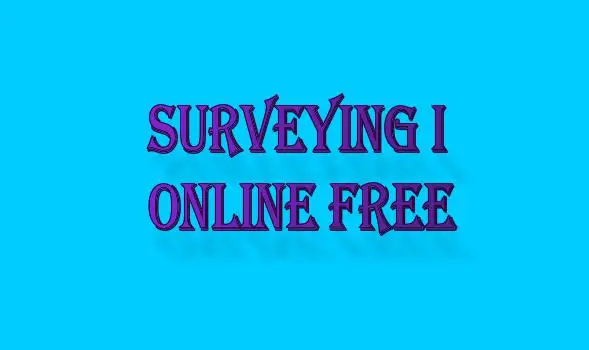
SURVEYING i
Types of Tags in Details used in metallic Chains
Length of a chain & its parts a 20 meter ChainSECTION OF A LEVELLING MANUAL MACHINE ALONG WITH PARTSLEVELLING MACHINE RECAP FOR BEGINER’S ALL PRACTICAL ASPECT’S OF LEVELLINGccessories Surveying Chain ranging rod Arrows etc.
PURPOSE OF SURVEYING IN CIVIL ENGINEERING PART II
PURPOSE OF SURVEYING IN CIVIL ENGINEERING PART I
Contour Map by Radial Method Using levelling Machine & Plane Table
CONTOURING & Leveling Part I-COUNTOURING MAJOR POINT TO KEEP IN MIND BEFORE FIELD WORK IS CONDUCTED
Direct Ranging with the use of a line ranger
DIRECT Ranging of a line, {HD 4K} Complete Demonstration and main Practical Aspects
Types of Chain & chaining Equipment’s Used in the method of Surveying
SURVEYING___BASICS & NEED OF LAND SURVEYING
W.C.B & R B {BEARING’S} WHAT IS IT AND HOW TO CONVERT IT
CHAIN{जरीब}Obstacale in Chaining Practical procedure in detail{{जरीब}प्रैक्टिकल प्रक्रिया में बाधा
CHAIN SURVEYING TYPE’S OF OBSTACLE IN SURVEYING{सर्वे मे विभिन प्रकार के अवरुद्ध}PRACTICAL PROCEDURE
RANGING OF A LINE { INDIRECT RANGING } COMPLETE
RANGING OF A LINE{ DIRECT RANGING } WITH THE HELP OF RANGING ROD’S
INTERSECTION METHOD BY BACK SIGHTING METHOD OF PLANE TABLE SURVEYING
INTERSECTION METHOD USING PLANE TABLE TROUGH COMPASS {METHOD OF SURVEYING WITH THEORY AND PRACTICAL
SURVEYING -RADIATION METHOD {METHOD OF PLANE TABLE SURVEY } COVERING THE THEORY AND PRACTICAL ASPECT
SURVEYING::PLANE TABLE SURVEYING & PROCEDURE OF SETTING THE TABLE,CENTERING,LEVELING AND ORIENTATION
SURVEYING {PLANE TABLE SURVEYING} प्लेन टेबल सर्वे उपकरण के सभी पार्ट्स/TROUGH COMPASS,SPIRIT LEVEL
CHAIN SURVEYING-PART’S OF A{ज़रीब} AND ALL CHAINING ACCESSORIES IN DETAILS ज़रीब सर्वेयिंग समस्त उपकरण
SURVEYING{सर्वेईंग}–PRISMATIC {प्रिसमतिक} COMPASS -PART OF PRISMATIC COMPASS IN HINDI
Laboratories’ Subjects like building material’s building constructions & maintenance Engineering, Civil engineering building drawing, building steel drawing/structures https://twitter.com/socialstings,https://www.youtube.com/@EngineersIndiaSolution,http://engineersindiasolutions.blogspot.com,public health engineering, Soil mechanics & foundation engineering, concrete technology, reinforced cement concrete drawings & reinforced brick structures, Transportation engineering, estimating costing & Valuation, R.C.C & transportation laboratories’ https://engineersindiasolution.com/ 2 https://engineersindiasolutions.wordpress.com/
KINDLY POST THE HTML LINK IN ANY BROWSER TO ACESS VIEW WRITTEN MATERAILS ONLINE IT WILL TAKE YOU TO MY BLOG OR ONE DRIVE THANK YOU 1.https://www.mohdtariq.facebook.com/
2. https://engineersindiasolutions.blogspot.com
3. https://twitter.com/socialstings

•Building acoustics are the method by which noise is controlled within a building. This includes measures in which to reduce noise when necessary (i.e. noise pollution) and how to ensure effective transmission of other sounds throughout a particular space.
•Acoustics looks first at the pressure levels and frequencies in the sound wave and how the wave interacts with the environment. This interaction can be described as either a diffraction, interference or a reflection or a mix of the three. If several media are present, a refraction can also occur •noise produced inside the hall like crying kids, the sound generated by type writers, fan, A/C, Refrigerators, etc.,
•equipment’s must be serviced properly.
•equipment should be placed on sound absorbing mount.
•Floor, wall and ceiling must be covered with suitable sound absorbing materials.
•Building acoustics can help to mitigate the effects of noise disturbance which can have negative effects on health, wellbeing and general quality of life. The Noise Policy Statement for England (NPSE) defines noise pollution as: Environmental noise – which includes noise from
•transportation sources.•When it comes to materials, softer materials such as carpet, fiberglass insulation, and foam padding tend to absorb sound well, while harder materials such as concrete and brick tend to reflect it. Wood can reflect sound well, but if holes are drilled in it, it can also absorb it.
•Ernst Chladni (1756-1827), the ‘father of acoustics’. Image from Wikimedia Commons. Ernst Chladni (1756-1827) is regarded by many historians as the ‘father of acoustics’ for his seminal experimental work on vibrations. He was also a well respected musician and inventor of musical instruments.
•the science that deals with the production, control, transmission, reception, and effects of sound is known Acoustics of Buildings
•In physics is foundational to the application in fields as varied as underwater sonar, ultrasound technology, architecture, music production, geology, communication, and atmospheric science
•While it may not be possible to avoid unwanted sounds completely, architectural acoustics allows interior designers to minimize unwanted distractions. While designing commercial spaces where music plays an integral part, architectural acoustics is used to ensure better reception of sound.
•Acoustical properties are those that govern how materials respond to sound waves, which are what we perceive as sound. We are all familiar with how a disturbance in a body of water will cause waves to develop and travel along the surface of the water in all directions away from the disturbance.
• Three factors affecting the acoustics of building
•i) Low ceilings help to reflect the sound towards the audience. ii) Sound absorbing materials are used in those parts of the hall where sound intensity is large. iii)Echo: The reflection of sound from a distant reflecting surface is known as echo
•Acoustic treatments are solutions that help to absorb or diffuse sound to improve the acoustic quality of a space. These treatments come in various forms, and some facilities may need multiple types of treatments to achieve the ideal acoustics for the space
•Different types of acoustic sensors:- such as microphones, hydrophones (underwater microphones), and accelerometers (which can indirectly detect acoustic vibrations). Each type of sensor is designed for specific applications, depending on factors like frequency range, sensitivity, and environmental conditions
•Four properties of sound: pitch, dynamics (loudness or softness), timbre (tone color), and duration.
Acoustics of Buildings IN Architecture
•Architectural Acoustics: The Art of Sound Design
•TO BE CONTINUED………………..
Atterberg and shrinkage limits liquid & plastic limits
Objective: To determine the range of water content which exhibits consistency of a given soil sample at liquid limit, plastic limit and shrinkage limit.
Theory: Liquid limit (LL): It is the water content at which a 2 mm wide groove in a soil pat will close for a distance of 12.5mm when dropped 25 times in a standard liquid limit device (casagrade apparatus).
Plastic limit (PL): It is the water content at which a thread of soil just begins to crack and crumble when rolled to a diameter of 3mm.
Shrinkage limit (SL): It is the maximum water content at which no change in volume of the soil mass occurs when the water content is further reduced.
Plasticity index (PI): The plasticity index (PI) is defined as;
PI=LL–PL
Liquidity index (LI): This index is defined as;
LI = (w – PL) / (LL – PL)
Apparatus
- Liquid limit device and grooving tool
- Shrinkage limit set consisting of shrinkage dish, glass plate with prongs, mercury and evaporating dish
- Large glass plate for plastic limit
- Distilled water
- Oven
- Balance of 0.01g accuracy
- Dessicator
- Water can
Spatula, cotton waste, duster and grease Procedure
Liquid Limit
- Take about 120g of dry soil passing 425µ IS sieve and mix it thoroughly with distilled water using spatula until the soil mass becomes homogenous paste.
- Adjust the liquid limit device with the aid of the gauge on the grooving tool to obtain the fall of cup equal to 1cm above the base. Turn the handle and practice to obtain a speed of 2 blows per second.
- Place the soil paste in the cup, level up to a depth of 1cm at the point, which comes in contact with the base. Divide this paste by drawing the grooving tool through the sample along the symmetrical axis of the cup, holding the tool perpendicular to the cup at the point of contact.
- Turn the handle at the rate of two revolutions per seconds and count the blows necessary to close the groove in the soil for a distance of 12mm.
- Take the sample of the soil paste from near the closed groove and keep in the water can to determine the water content.
- Repeat the above process three or four times by adding some distilled water each time. Adjust the amount of water by visual judgment so that two readings are above 25 and two below 25 blows. However, the blows should not be lower than 15 nor greater than 35.
- Preserve this soil for shrinkage limit test.
- Draw the flow curve, and determine the liquid limit.
Plastic limit
- Take about 20g of soil passing through the sieve of size 425Pm and place it on a glass plate. Mix it thoroughly with distilled water until it is plastic enough to be rolled.
- Roll the soil between the hand and the glass plate so as to form a thread of 3mm diameter.
- Knead the soil together and roll again until a 3mm diameter thread shows sign of crumbling.
- Take some of the crumbling material obtained in step 3 for water content determination. This defines the plastic limit.
- Repeat steps 2 to 4 three times so as to obtain average plastic limit.
Shrinkage Limit
- Place about 30g of the soil fraction passing 425Pm IS sieve in a porcelain dish and thoroughly mix it with distilled water. The water should be added to make the soil slightly flowing.
Note: The amount of required water could be about the liquid limit in low plastic (friable) soils; otherwise it could be about 1.1 to 1.2 times the liquid limit in medium to high plastic soils.
- Apply a thin coat of grease to the inside of the shrinkage dish and measure its empty weight.
- Place the soil paste in the shrinkage dish, simultaneously tapping it so that it fills completely the dish without entrapping any air bubbles. Weigh the dish with soil paste inside.
- Keep the dish in the oven set at 105 to 1100C for 24 hours. Take the dry weight of the soil pat.
- Determine the volume of the dry soil pat by mercury displacement method *
- Determine the volume of the dish by filling it with mercury.
- Enter the observation in the record sheet and compute the shrinkage limit.
*****Important: Every precaution should be taken while handling mercury (e.g. your finger nails should be trimmed). For detailed safety requirements, you are advised to refer to the web page http://www.ilpi.com/safety/mercury.html
References:
IS 2720 (Part 5): Determination of liquid and plastic limit
IS 2720(Part 6): Determination of shrinkage factors
Technical Solution for all work’s from framework shuttering designs all shapes for POLYGON,PENTAGON,OVAL,SYMETRICAL,SPHERICAL STAIR,SLAB’SBEAMS,COLUMNS AT NOMINAL & EASY GOING LABOUR COST’S FOR YOU ALL LEARN FREE & DO YOUR WORK FREE OF COST FROM MY SIDE
YOU DREAM & I WILL MAKE IT COME TRUE
WAITING FOR YOUR PRECIOUS SUGGESTIONS TO ADD MORE
Cantilever Over Hanging Beams etc
KINDLY POST THE HTML LINK IN ANY BROWSER TO ACESS VIEW WRITTEN MATERAILS ONLINE IT WILL TAKE YOU TO MY BLOG OR ONE DRIVE THANK YOU
Laboratories’ Subjects like building material’s building constructions & maintenance Engineering, Civil engineering building drawing, building steel drawing/structures https://twitter.com/socialstings,public health engineering, Soil mechanics & foundation engineering, concrete technology, reinforced cement concrete drawings & reinforced brick structures, Transportation engineering, estimating costing & Valuation, R.C.C & transportation laboratories’
SURVEYING

https://youhttps://engineersindiasolutions.blogspot.com/tu.be/l1YN49v8Xno


MORE AS PER YOUR REQUIREMENTS IN ENGLISH OR HINDI CC CAN BE PROVIDED IN ALL LANGUAGE’S THA
Demonstration of Unconfined Compression Test
OMC & PROCTOR COMPACTION TEST using light & Heavy compaction (1& 2)
https://docs.google.com/document/d/1TM4amnW36TNK2bAORejs0R0xTTuIyV7B/edit?usp=sharing&ouid=109276551282465841885&rtpof=true&sd=true
Soil Mechanics,PROJECT,Survey Camp,R.C.C Drawing,HIGHWAY LAB,CONCRETE TECHNOLOGY etc in Progress

ON THE GO
34 years OF SERVICE in this field 14 YEARS AS LECTURER REST YEARS WITH PROFESSNAL ETHIC’S –RECENTLY RETIRED SO BUILD A KNOWLEGE HUB

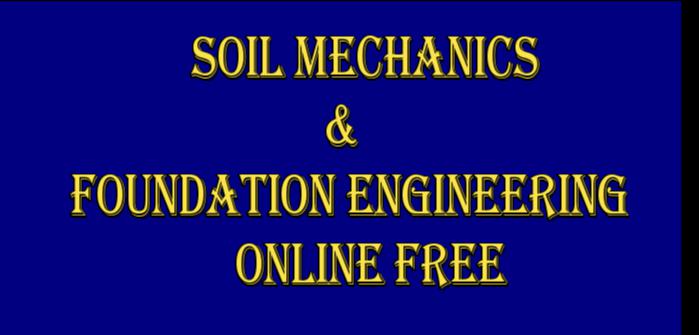
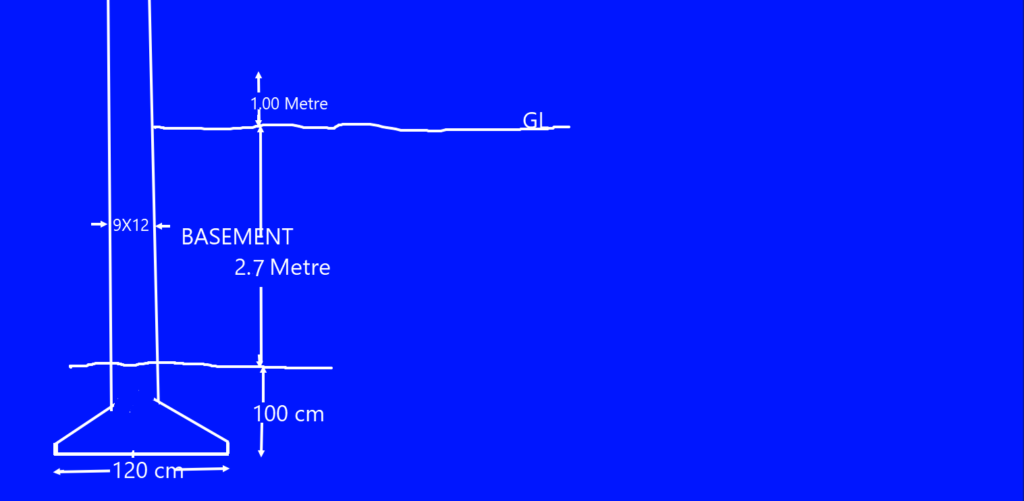
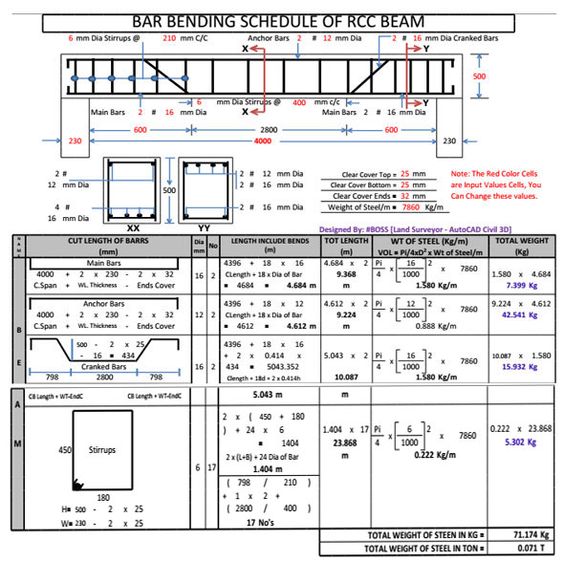

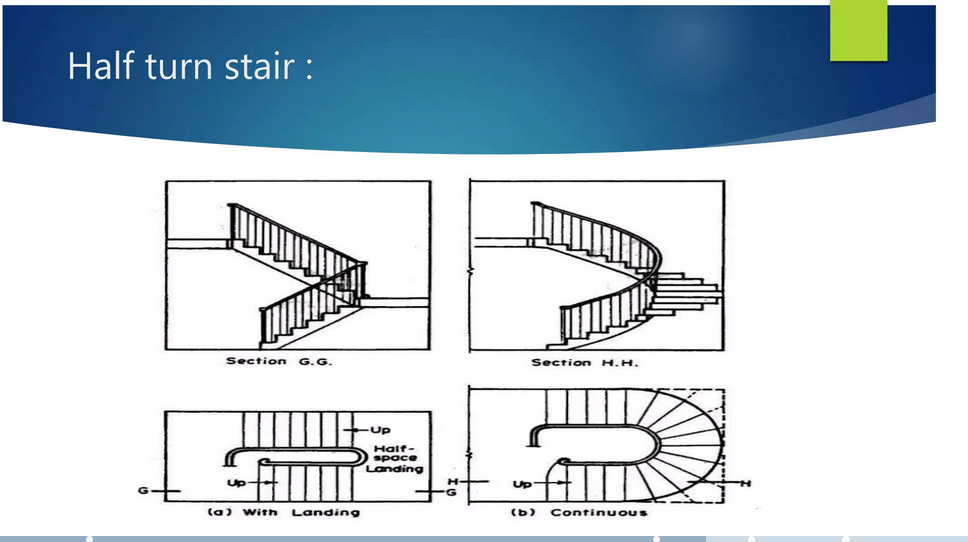

Platform For You
Established
2018
When we founded our company
Growth
ÉDUCATION GRATUITE OUVERTE À TOUS
Feature Title 1
Laboratories’ Subjects like building material’s building constructions & maintenance Engineering, Civil engineering building drawing, building steel drawing/structures https://twitter.com/socialstings,public health engineering, Soil mechanics & foundation engineering, concrete technology, reinforced cement concrete drawings & reinforced brick structures, Transportation engineering, estimating costing & Valuation, R.C.C & transportation laboratories’
Feature Title 2
FULL ACCESS TO THE ACESSOR AT YOUR NEED RELATED TO LABORITRIES ONSITE WORK PRACTICAL’S RELATED THEORY FOR CIVIL ENGINEERING AT DEGREE,DIPLOMA & I.T.I LEVEL AND RELATED COURSES OF SURVEYING BUILDING MATERIALS CIVIL ENGINEERING DRAWING’S ESTIMATION & PROJECT WORK’S ALONG WITH PROPER GUIDENCE FOR MODEL MAKING AT EDUCATIONAL LEVEL’S MENTIONED ABOVE
Feature Title 3
34 years OF SERVICE in this field 14 YEARS AS LECTURER 10 YEARS AS ASSISTANT PROFESSOR & REST AS PROFESSOR –RECENTLY RETIRED SO BUILD https://engineersindiasolution.com/
Feature Title-4
Sujets de laboratoires tels que l'ingénierie de construction et d'entretien des matériaux de construction, le dessin de bâtiment de génie civil, le dessin/structures en acier du bâtiment https://twitter.com/socialstings, l'ingénierie de la santé publique, la mécanique des sols et l'ingénierie des fondations, la technologie du béton, les dessins de béton de ciment armé et structures en briques renforcées, ingénierie des transports, estimation des coûts et valorisation, R.C.C et laboratoires de transport

More #
Feature Title 5
Themen der Laboratorien wie Baustoffkonstruktionen und Instandhaltungstechnik, Bauzeichnungen im Tiefbau, Baustahlzeichnungen/-strukturen https://twitter.com/socialstings, öffentliche Gesundheitstechnik, Bodenmechanik und Grundbau, Betontechnologie, Stahlzementbetonzeichnungen und Bewehrte Ziegelkonstruktionen, Verkehrstechnik, Kostenschätzung und Bewertung, R.C.C. und Transportla https://engineersindiasolution.com/
TILLAR UCHUN AC PER IUR ISHLAB CHIQISH
Предмети лабораторій, такі як будівельні конструкції та технічне обслуговування будівельних матеріалів, креслення будівель цивільної інженерії, креслення/конструкції зі сталі https://twitter.com/socialstings, інженерія охорони здоров’я, механіка ґрунту та інженерія фундаменту, технологія бетону, креслення залізобетону та армовані цегляні конструкції, транспортна інженерія, калькуляція та оцінка, R.C.C та транспортні лабораторії"
Business Tips
Latest Articles From Blog
Demonstration of Unconfined Compression Test
https://engineersindiasolutions.blogspot.com/2024/04/demonstration-of-unconfined-compression.html
METHOD OF QUARRING AND PRSERVATION OF STONE
Principle to Building Planning
THEODOLITE progress radial method https://docs.google.com/presentation/d/1XTjnbsxyDli3ZvInhNYgvMlb3kQ2Fg06/edit?usp=share_link&ouid=108938057700723052405&rtpof=true&sd=true

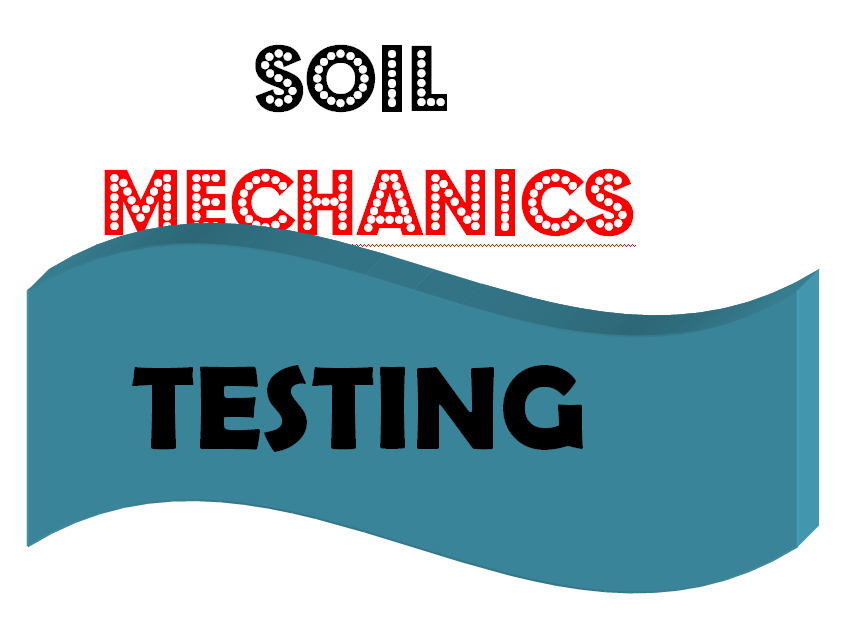

ईंधन और दहन: ### ईंधन का दहन और विशिष्ट गुण
ईंधन और दहन: ### ईंधन का दहन और विशिष्ट गुण #### **विस्फोट और दस्तक प्रतिरोध** **विस्फोट** असामान्य दहन का एक रूप है, जिसमें इंजन के सिलेंडर में ईंधन-वायु मिश्रण का तेजी से, अनियंत्रित जलना शामिल है। इससे उत्पन्न उच्च दबाव वाली शॉक तरंगों के कारण इंजन को नुकसान हो सकता […]
Types, properties and uses of varnishes
Types, properties and uses of varnishes Varnish may be defined as a mixed solution of resins or resinous substances (such as common resin, amber, copal, shellac, etc.) in alcohol, turpentine, or oil. Varnishing is utilized on wood surfaces with the following products: (i) To intensify or brighten the appearance of […]
RLC Bridge Measure Resistance#Engineering@Basic_Engineering

Measurement of resistance and inductance of coil using RLC Bridge Introduction : A bridge is an electrical circuit in which two circuit branches (usually parallel with eachother) are bridged by a third branch connected between the first two branches at some intermediate point along them. Bridge circuits find many applications […]